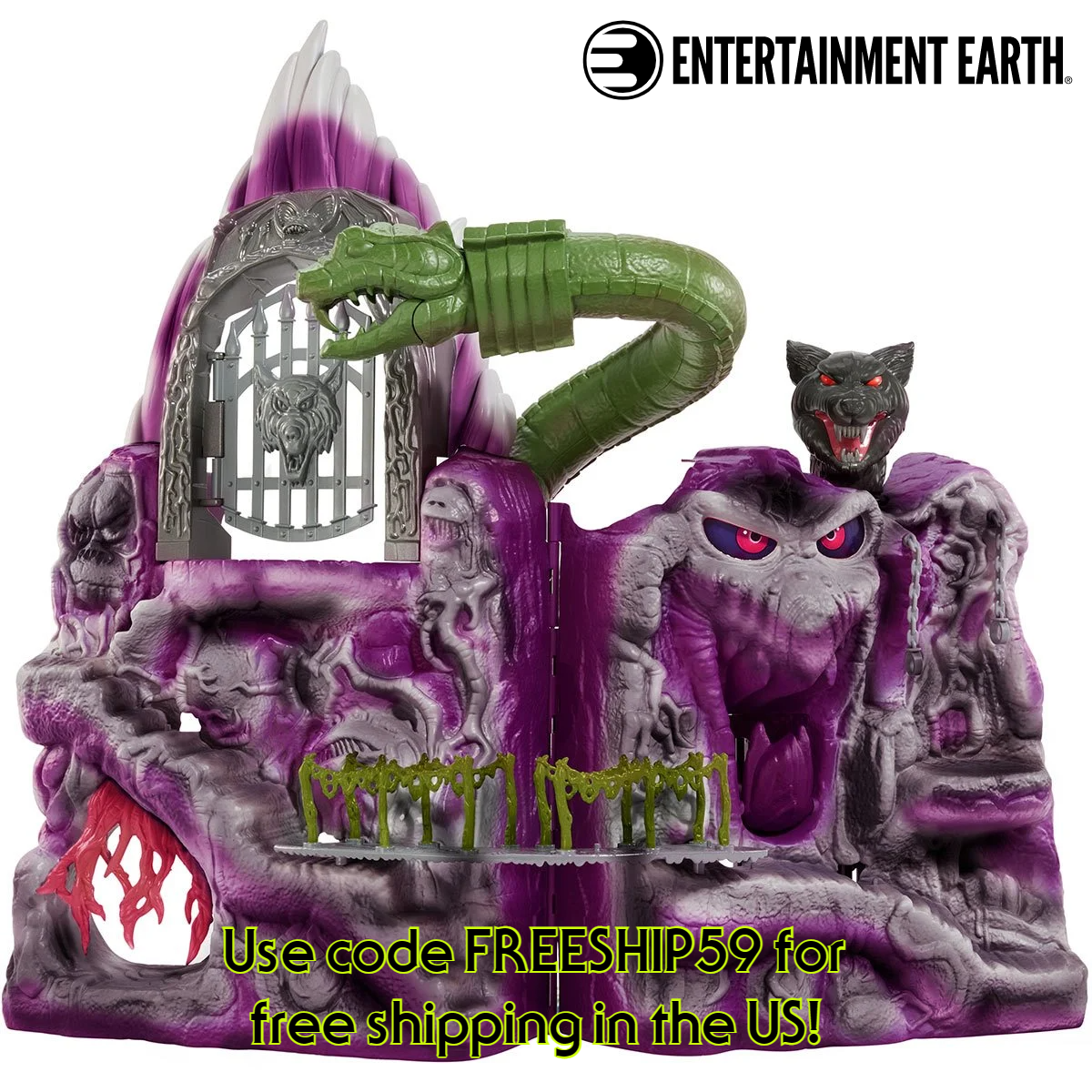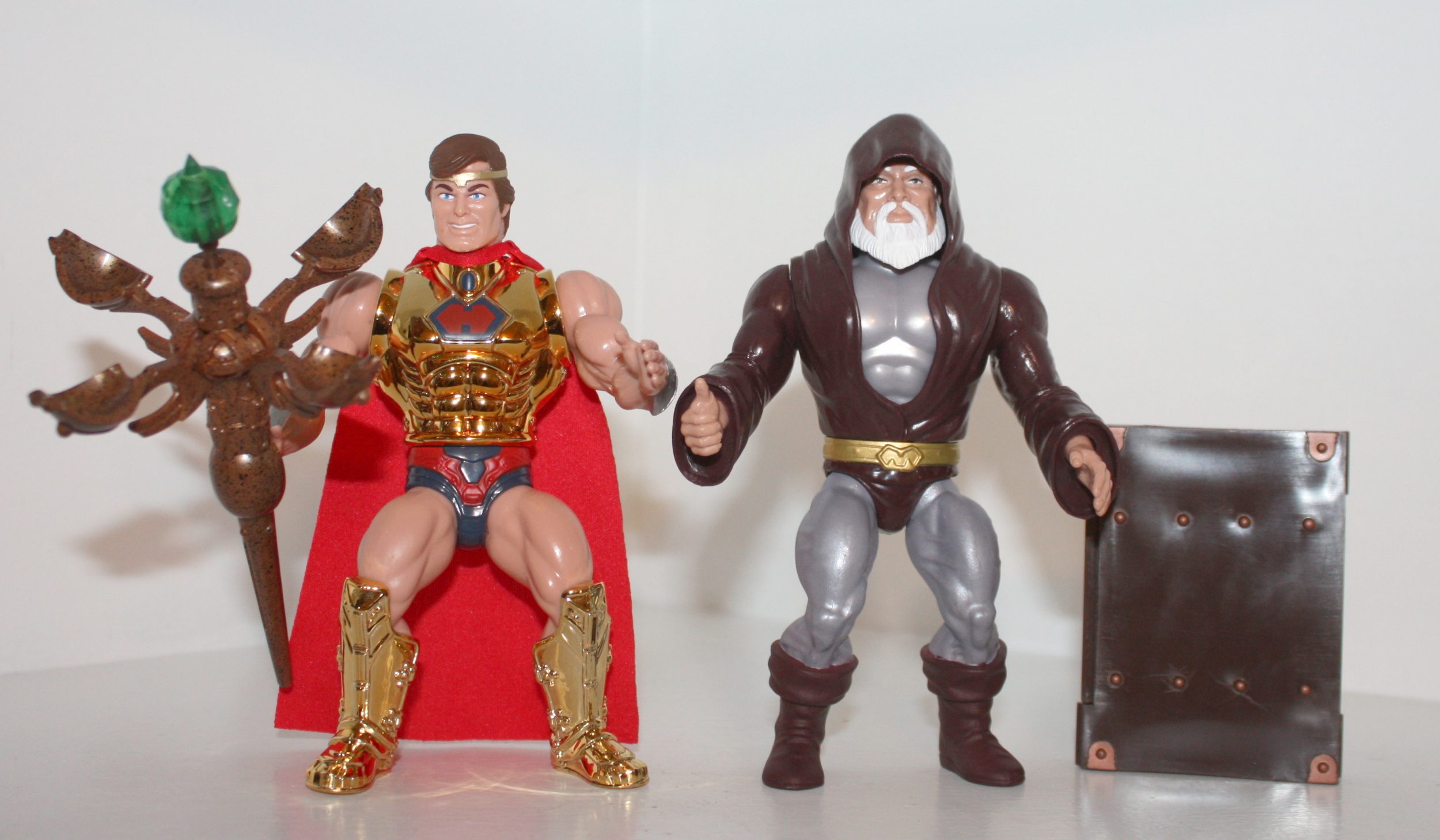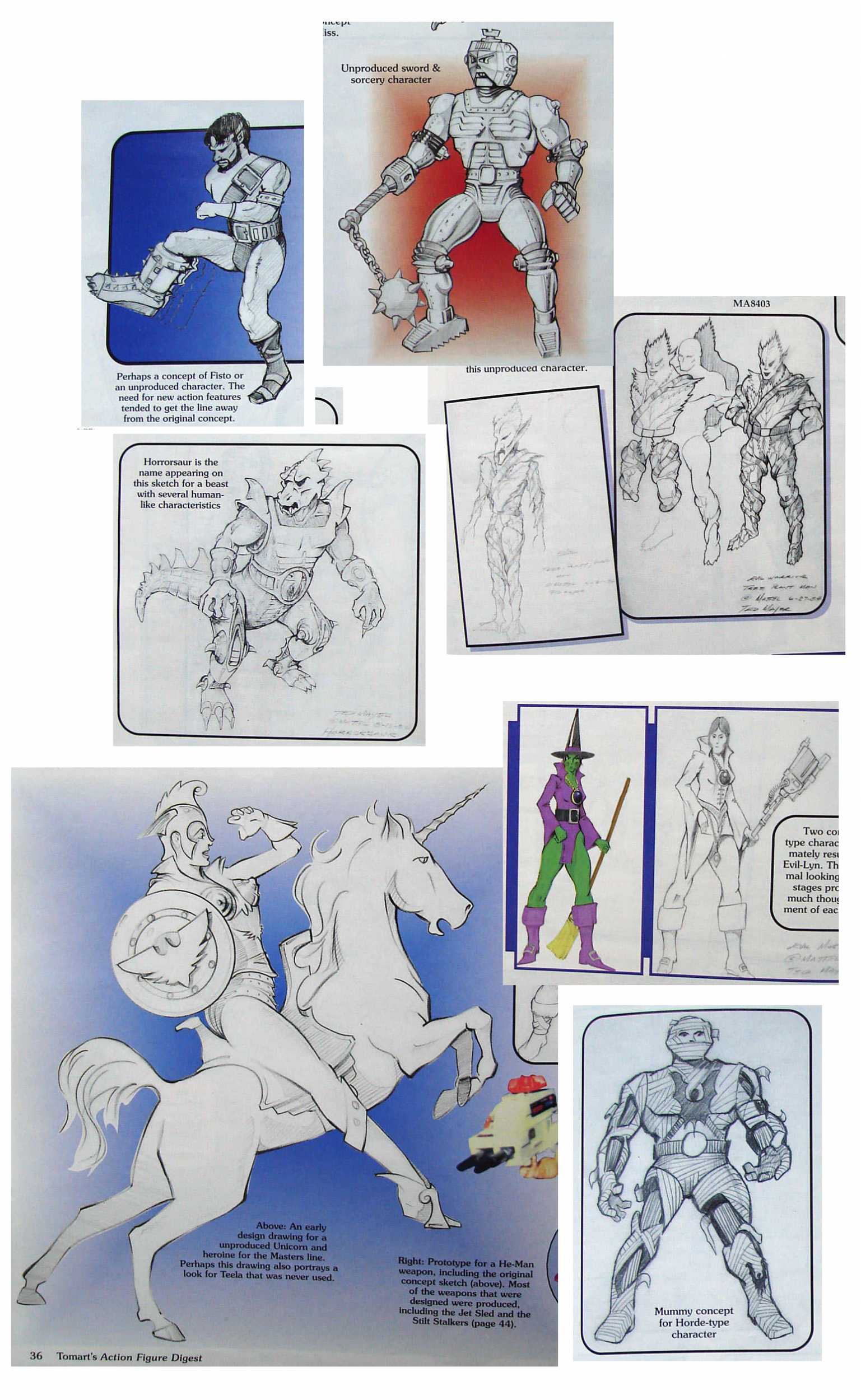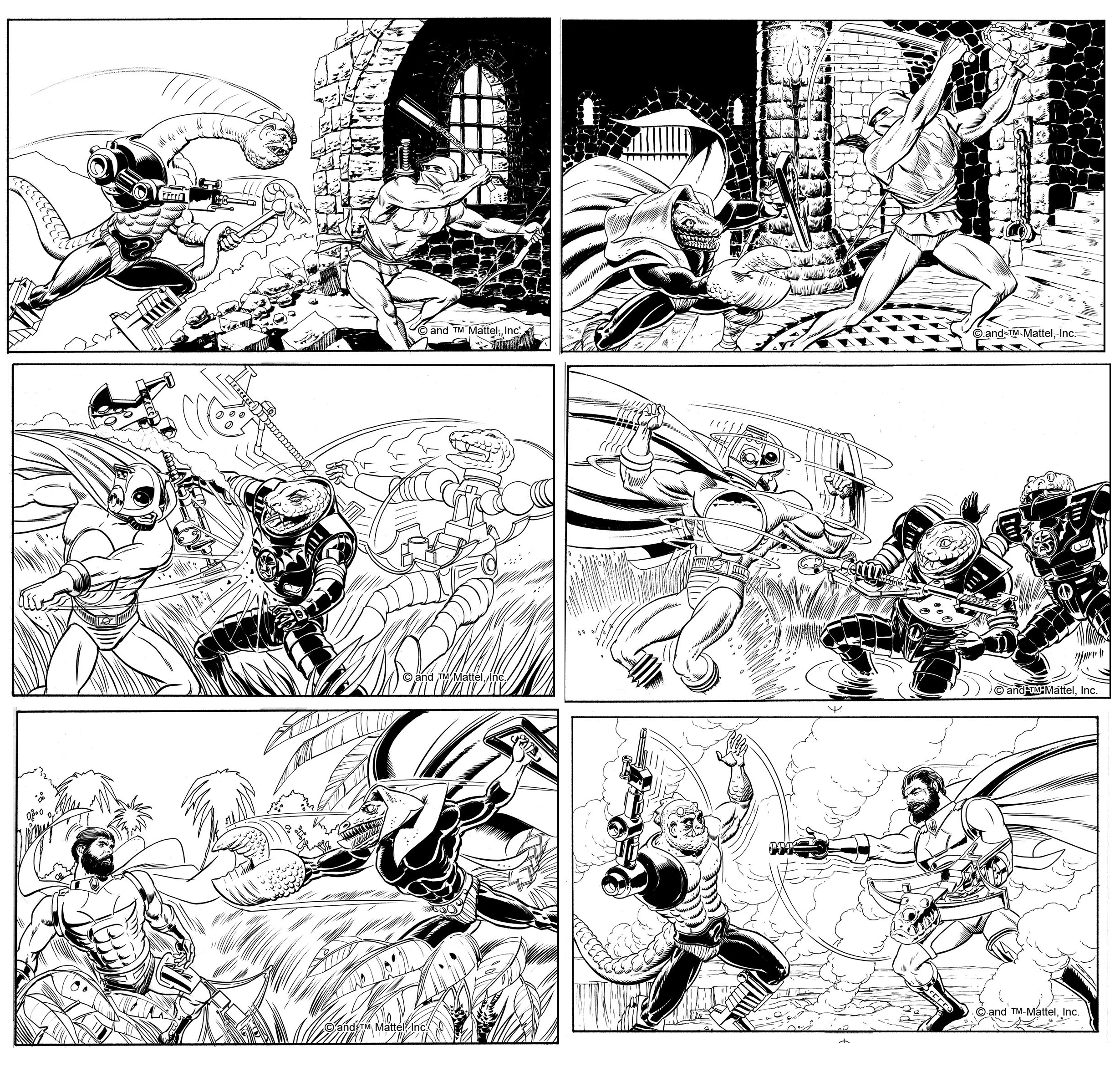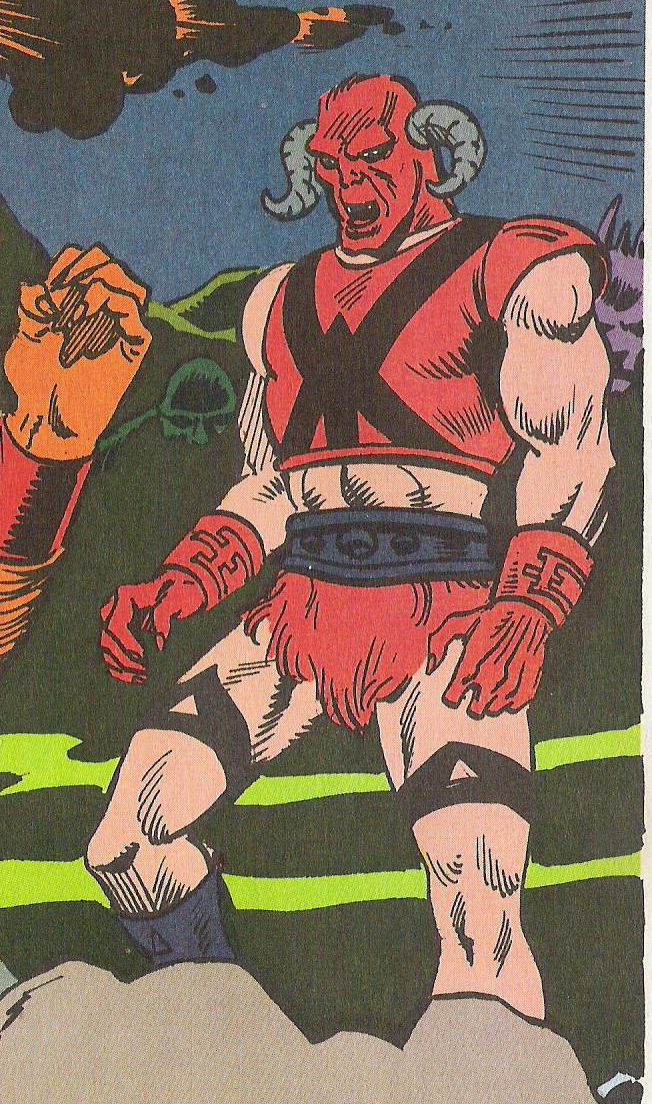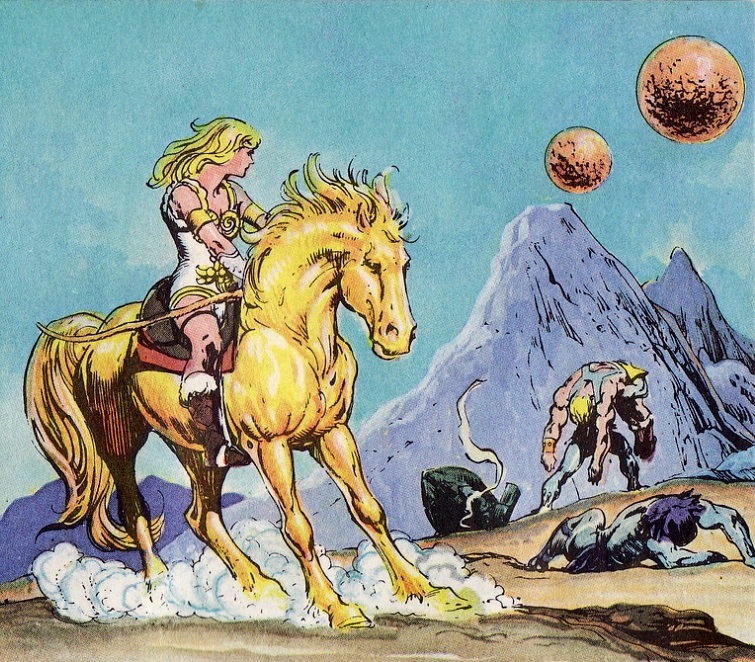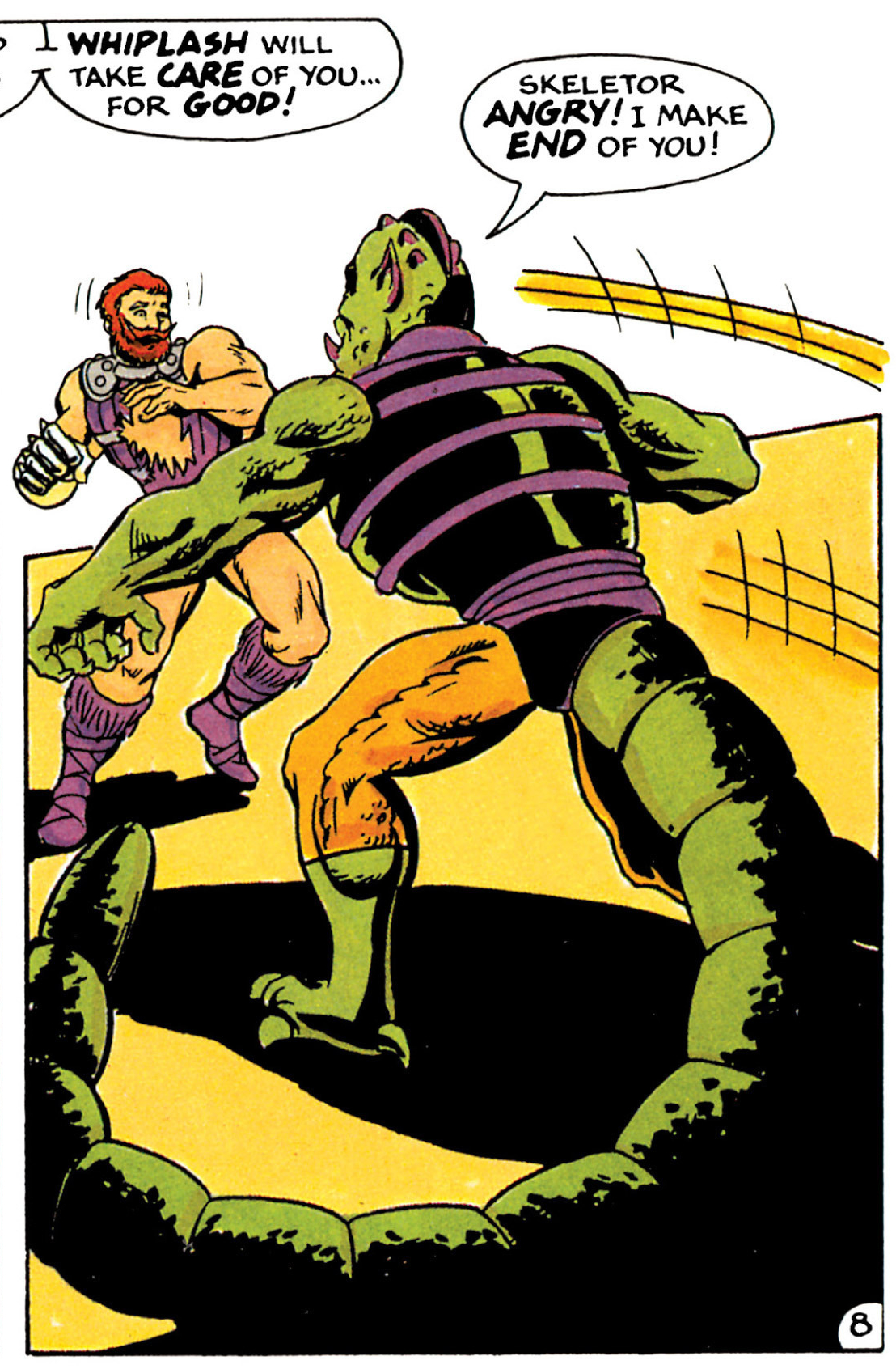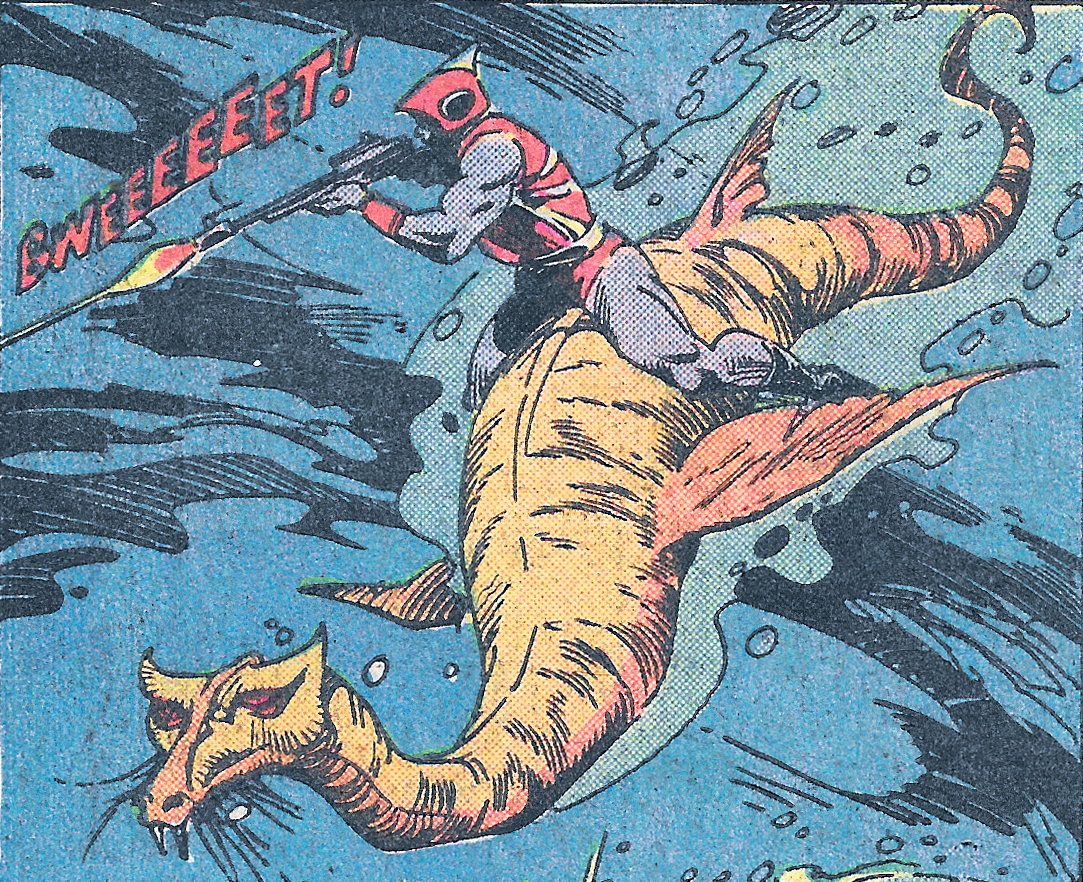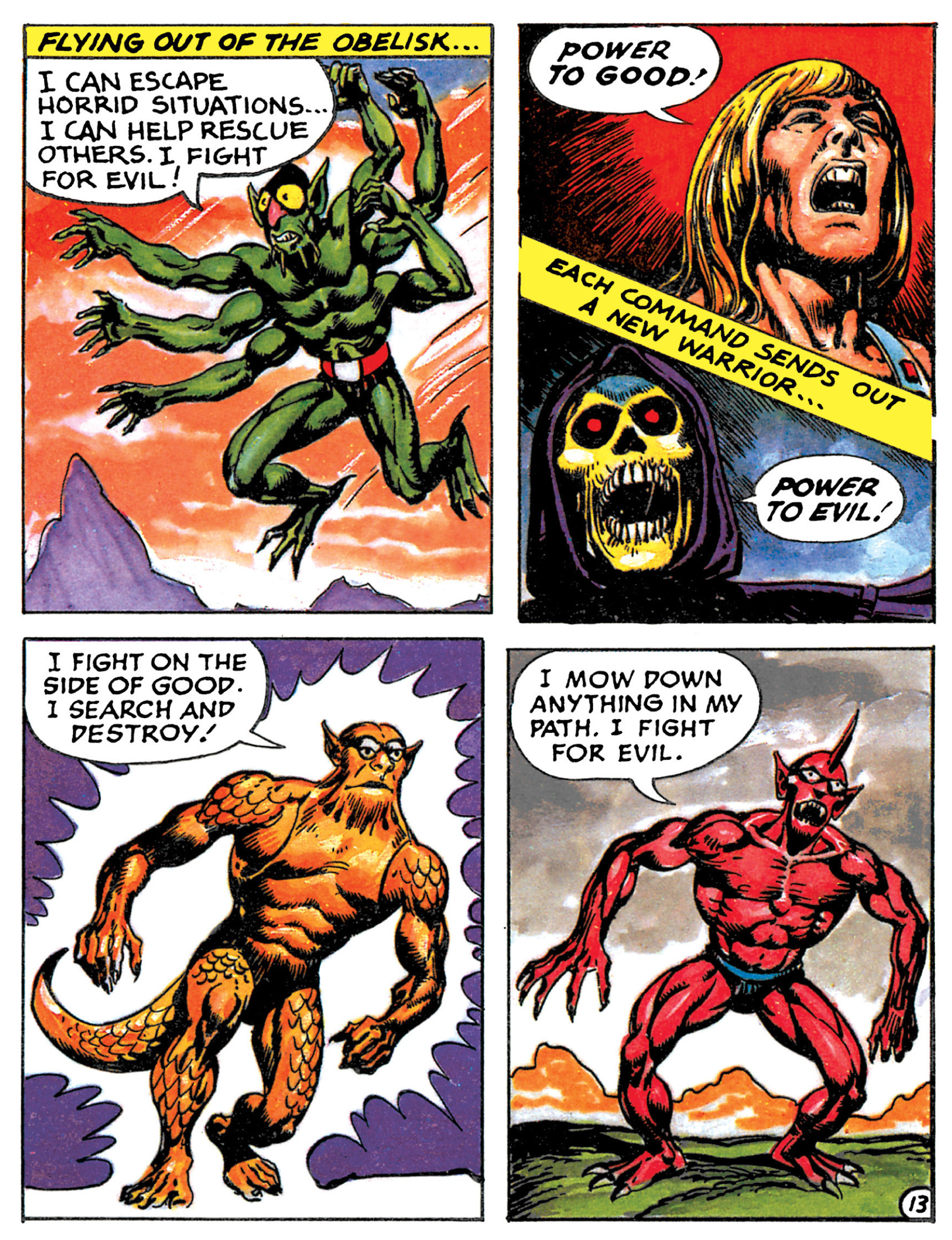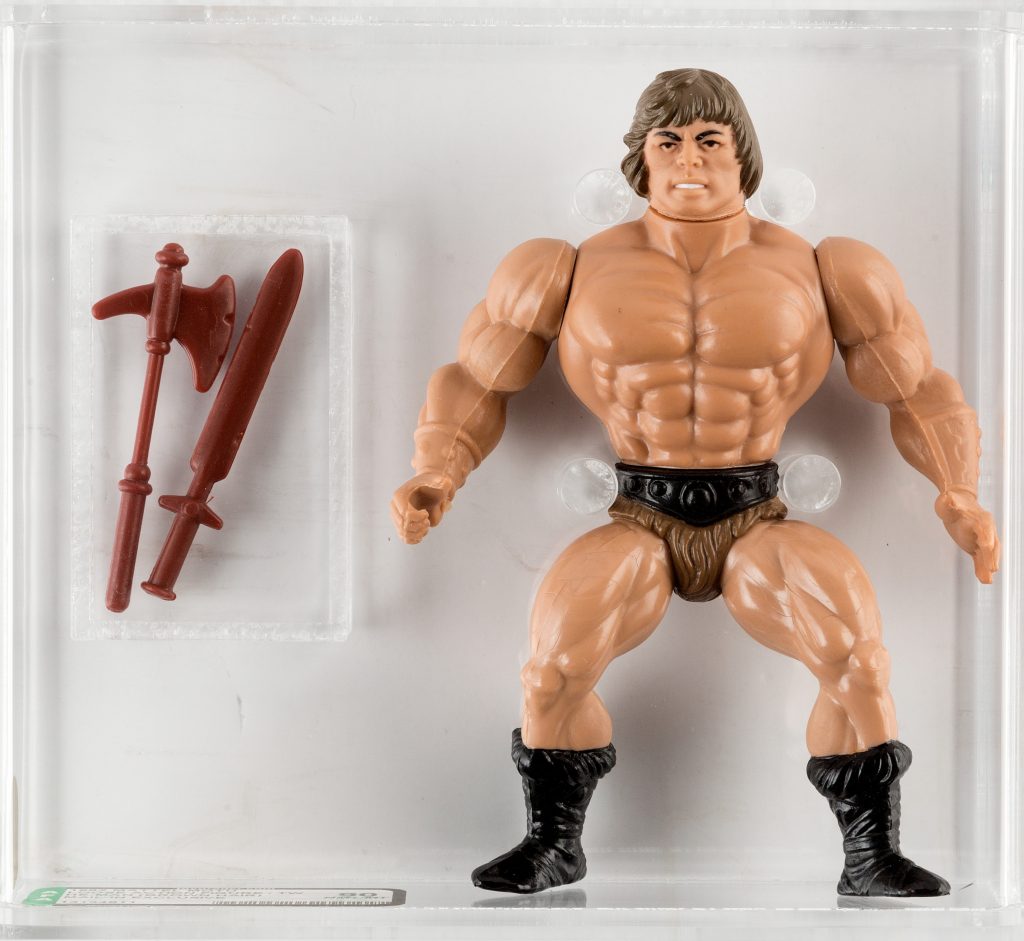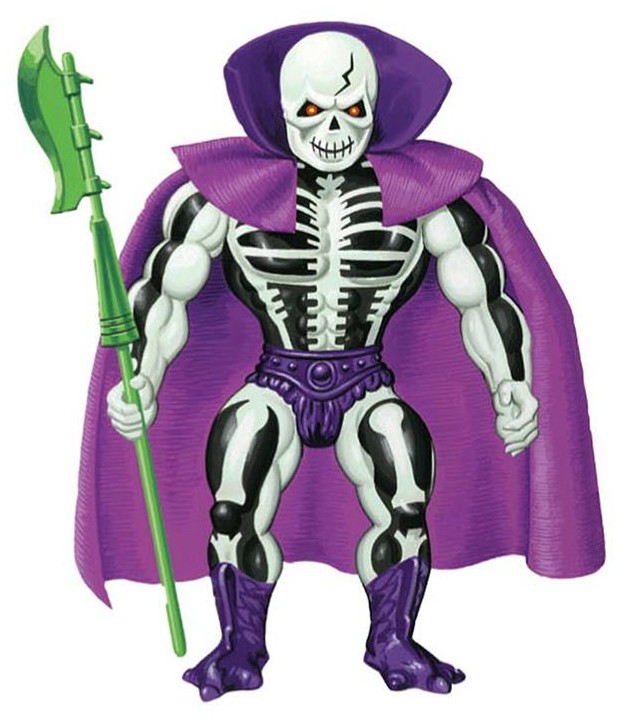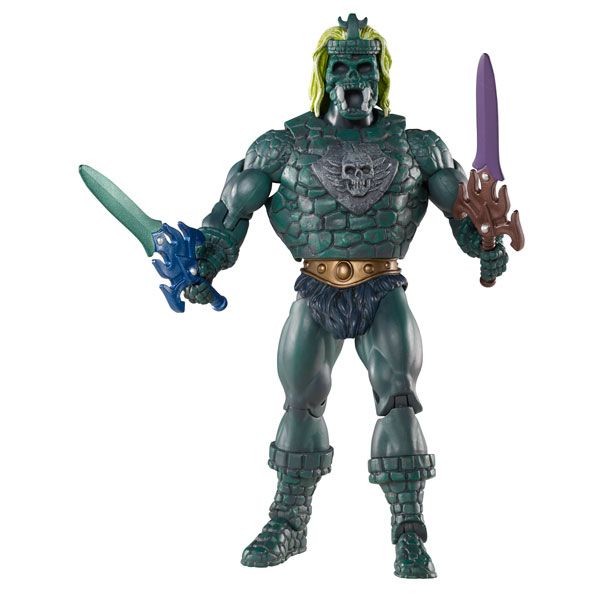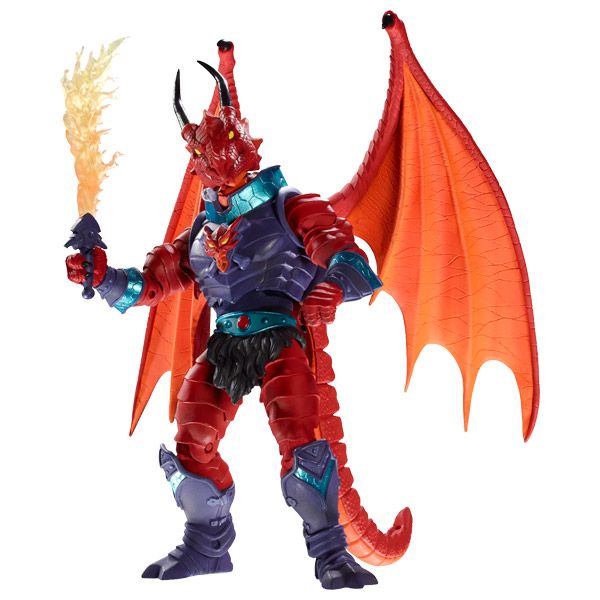
Because Masters of the Universe figures were produced over many years in a number of different countries, there is no shortage of production variants, some subtly different and some radically different from the norm. In my own collecting, I’ve always gravitated toward the earliest figures released in the US, particularly for the first wave of figures. They tend to have the nicest paint and plastic applications, in my opinion. All of the 1982 lineup was manufactured in Taiwan, except for Castle Grayskull, Battle Ram and Wind Raider, which were initially manufactured in the US. A common term for the very earliest figures in the line is “test market figures”, although the term isn’t usually used for the vehicles or Castle Grayskull.
Much assistance for this article was given by John Oswald. The research of Mantisaur82 and Tokyonever has also been invaluable.
Broad Characteristics
The early Taiwan figures tend to have the sharpest detail and the finest paint applications compared to later reissues. Subsequent releases tend to cut down on the paint applications and sometimes on the sculpted detail. The earliest figures tend to have boots that are painted on using spray paint and a paint mask, which sometimes shows up as unevenness at the boot tops. Later figures seem to use a dipping method. Since this seems to apply to all the early figures (or at least those with painted boots), I won’t mention this when I talk about each individual figure.
On the lower backs of the figures (or in Teela’s case, the lower part of the back of the head) they are stamped © Mattel Inc. 1981 Taiwan. This stamp can also be found on the undersides of the male heads. These figure were released in 1982, but most MOTU figures are stamped the year before they were sold in stores, when the tooling was being created. However, as these Taiwan figures were released in subsequent years, they often retain the 1981 date, albeit sometimes with a slightly larger font.
He-Man
The very first versions of He-Man tend to have a certain coloring – dark orange belt (later versions could range from light orange to mustard yellow to coral), brick-red boots and loin cloth, and dark gray accessories. He has a belly button, which was eventually removed from the mold starting in 1983 (although some 1983 figures seem to still have it). Some of the early accessories seem to be slightly blue-tinged. The straps on the back of his harness have short tabs on them – they were lengthened in subsequent releases to make it easier for children to hold when putting the armor on.
Early versions seem to have a tighter fitting latch in back as well, and intense yellow hair. It’s very common to see the boots not painted all the way up to the top in these early figures. If they are painted all the way to the top, there is usually some uneven overspray in some areas regardless. Later figures have the boot color applied by dipping the legs in paint.
His accessories are stamped with code numbers that indicate He-Man’s SKU number (5040), a number to indicate which accessory it was, and “© Mattel Inc. 1981 Taiwan.” All of them, except for the shield, include another number that is separated from the others. I believe it’s a batch number. So an axe marked 2 is from an earlier batch than one marked 7. That’s my theory – I don’t know this for sure. His shield lacks any code numbers, and is simply marked “Taiwan.”
Update: I’ve added some more detailed observations about the earliest Taiwan He-Man figures. The differences I’m noting immediately below are not from year to year, but within the first year of production of He-Man figures (1981, sold beginning early in 1982):
Hair: the early figures’ hair seems to be intense yellow, almost orange tinged. Slightly later in year the hair starts to be a lighter yellow color. I’ve found two main types of paint used – a glossy textured kind of paint, and a non-textured paint that seems almost like a dye.

Belt: the earliest ones are dark orange. The color is a bit lighter as you get later in the year, for instance on carded 8-back He-Man figures that have the warranty information added.
Belly Button: the earliest ones (sold on 8 backs without warranty) are a bit uneven looking. By the time you get to the 8-backs with warranty, the belly button looks anatomically correct.

Waist Punch Feature: the earliest versions have a stopper, so when you twist the waist, it swings back to punch, but stops in the middle. A bit later in the year that stopper was removed, so the punch action doesn’t stop quite in the middle, but keeps moving a bit beyond that. This is also evident in early Skeletor figures, as well as all other first release first wave figures.
Sword: the early ones seem to be marked 4 or 9. The earlier numbered swords tend to be a darker blue/gray color, although you can look at many examples and few will be the exact same shade.
Axe: the early ones are marked 2 or 7. The earlier numbered axes tend to be a darker blue/gray color, although you can look at many examples and none will be the exact same shade.
Harness: the early ones are marked 5 or 10. The 5s I’ve seen seem to be a dark gray/blue, with small oval tab on the latch in back. The 10s seem to have more of a almost multi-hue gray plastic, slightly brighter red paint, and a slightly elongated tab on the back. Both have short straps, and both seem to appear very early, although the 10s seem to persist later in the year. 15s look very similar to 10s and come later still.
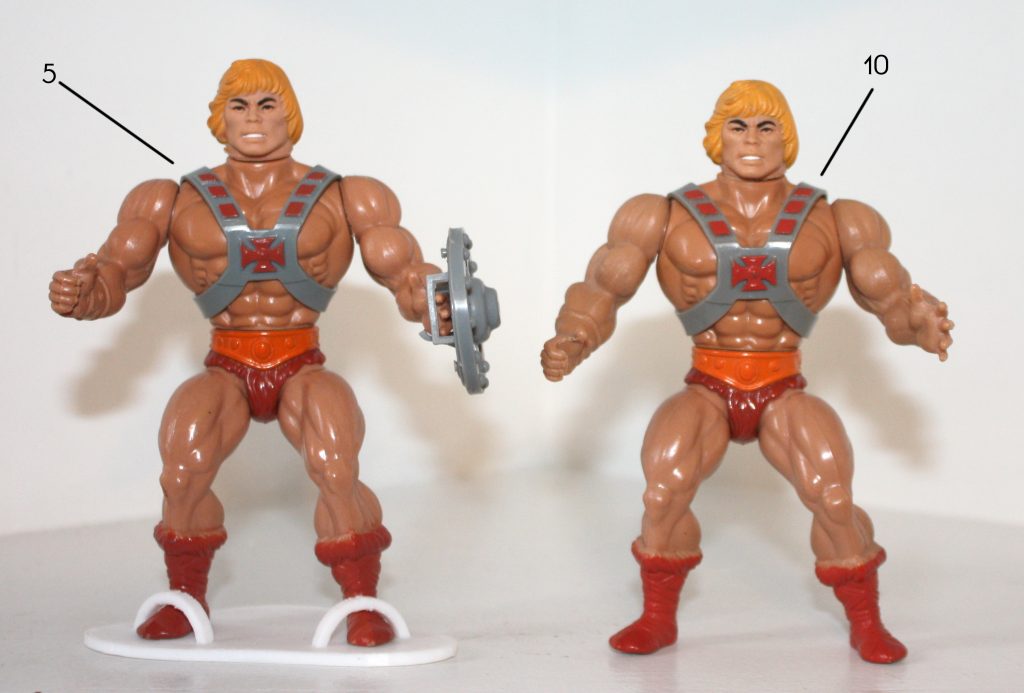
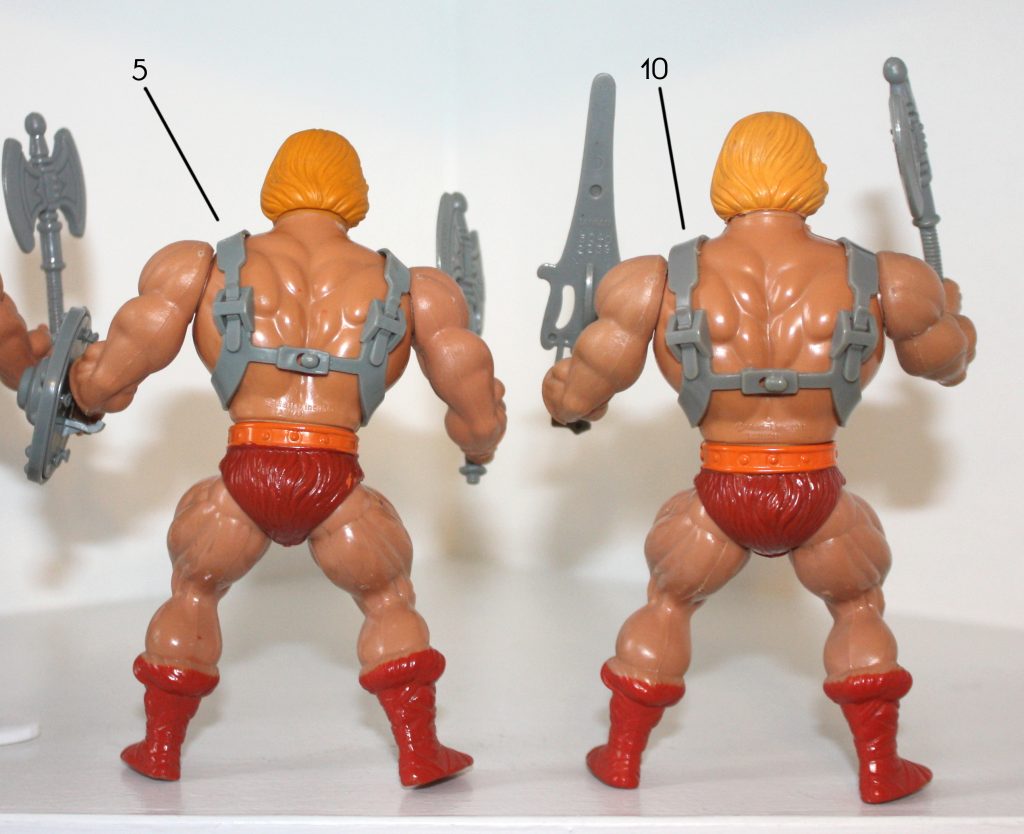
I should say that I believe sometimes accessories with the markings outlined above did persist later than early 1982. In general, however, the trend seems to be for the numbers to go higher with time. I’ve seen numbers as high as 33 on later figures.
Shield: Early ones are marked Taiwan. The tabs on the back should be more or less intact. Slightly melted at the top, but not completely melted to the back of the shield, as happened later in production. The exact shade of gray varies quite a bit.
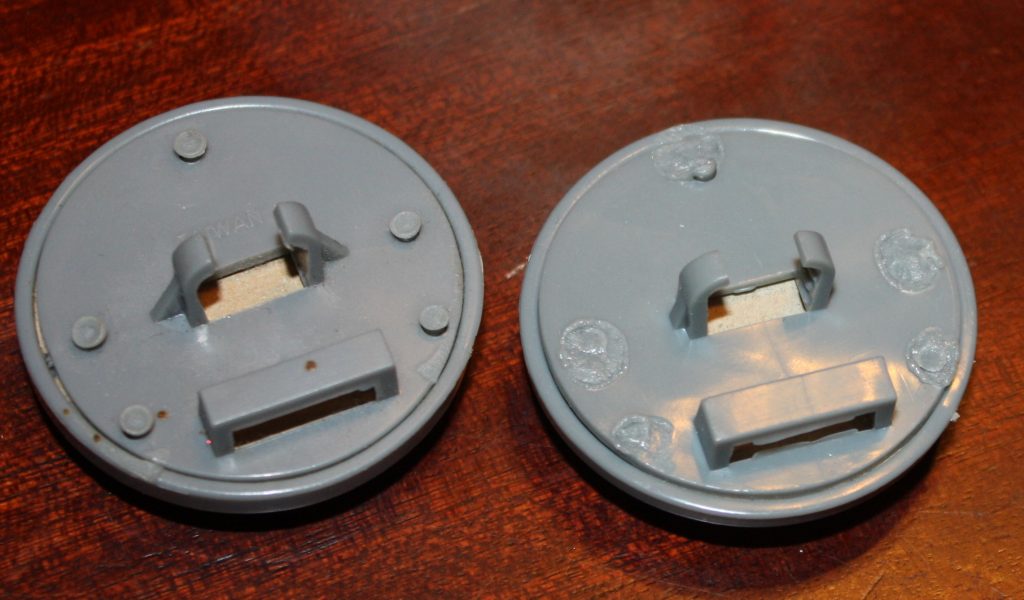
Here are some examples of four early He-Man figures. The two figures on the left are the earliest, although I couldn’t say which came first. The figure second from the right came later in the year (it lacks the stopper in the waist punch feature), and the one on the far right came later still.
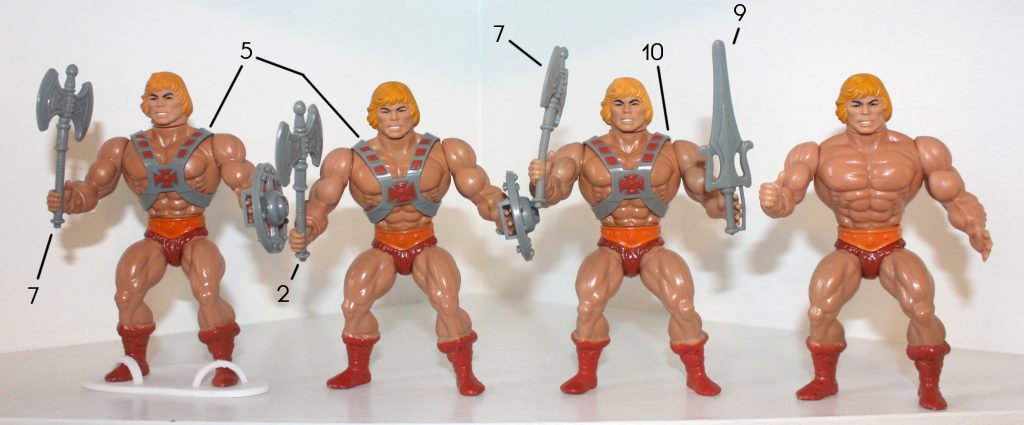
And here are my two earliest Taiwan He-Man examples (below, and above on the left). Both have harnesses marked 5. The one on the left has some overspray on the chest emblem, which isn’t too uncommon. The one on the left also has weapons with the earlier number markings, and they are slightly darker gray/blue.
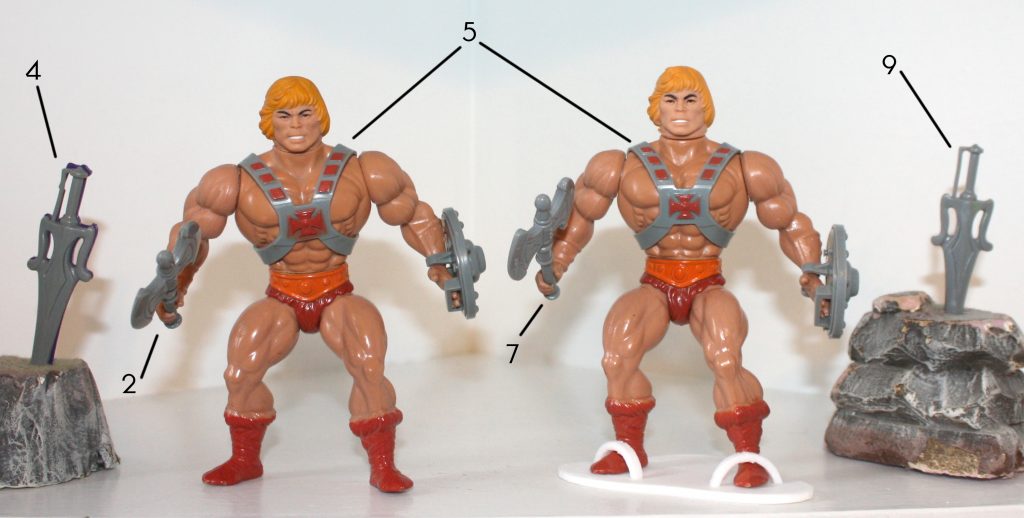
Here is an example (below) of a very early carded Taiwan He-Man, which can be recognized by the lack of warranty and lack of SKU/character subtitles on the back. This is often referred to as the “test market” card. This example of He-Man has boots painted closer up to the top and the darker blue/gray harness and shiny hair paint, similar to the loose example (above, on the right)


After 1982, the first substantive change to Taiwan He-Man figures was the lengthening of the straps, as shown in this comparison image:
The second substantive change to Taiwan He-Man figures was the removal of the “belly button”, as shown here:
Skeletor
The first Taiwan Skeletor is unique in the following ways:
- Orange marks on his “cheeks”
- Half-painted boots
- Purple trunks
- Light blue paint in his eye sockets
- Short straps on the back of his armor
The subsequent Taiwan release omits the orange cheeks. The next version after that has black shorts, and the version after that gives him fully-painted boots. Later still, he loses the light blue paint in his eye sockets. There are “mix and match” versions out there too, with odd combinations of these features. Perhaps this was from the factory mixing older leftover parts with newer parts. Later versions also omit the “belly button.”
The early Skeletor’s staff is marked Taiwan, and his sword is also marked simply as Taiwan (later versions of the sword add some code numbers on the underside as well). This early example has rather brittle accessories, so I won’t remove them to discover what codes are under his chest armor and belt.
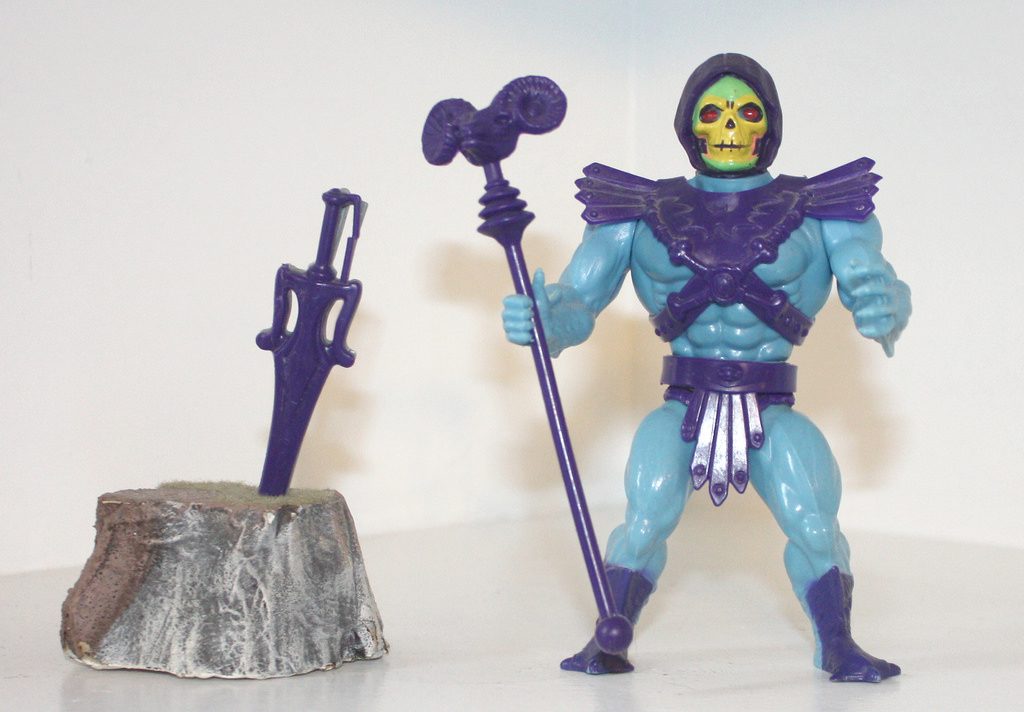
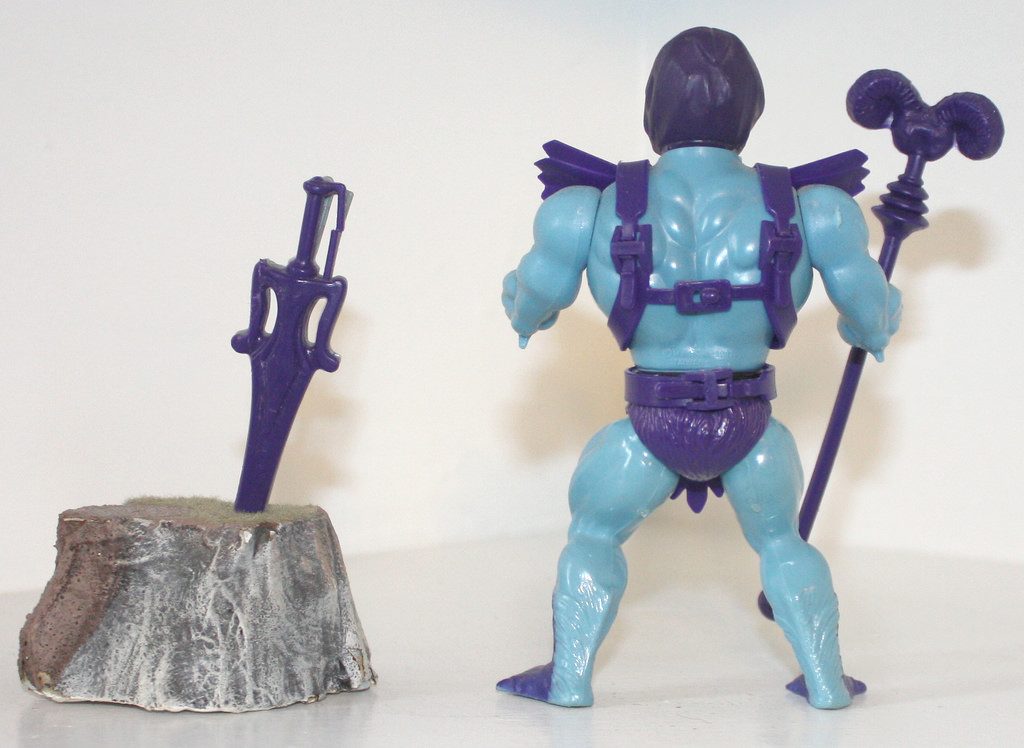
Here is an example of a very early carded Taiwan Skeletor, which can be recognized by the lack of warranty and lack of SKU/character subtitles on the back.
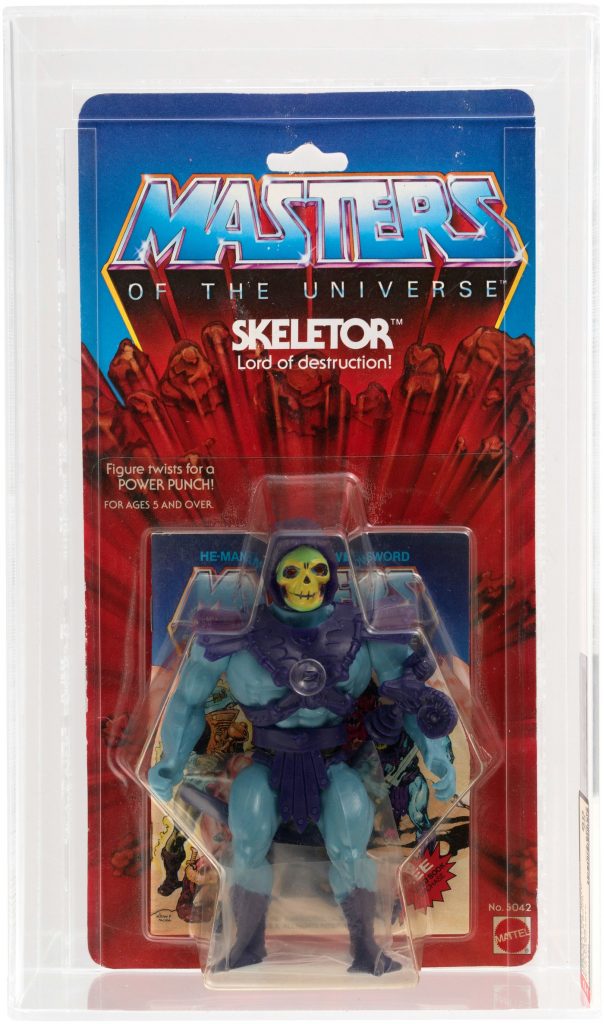
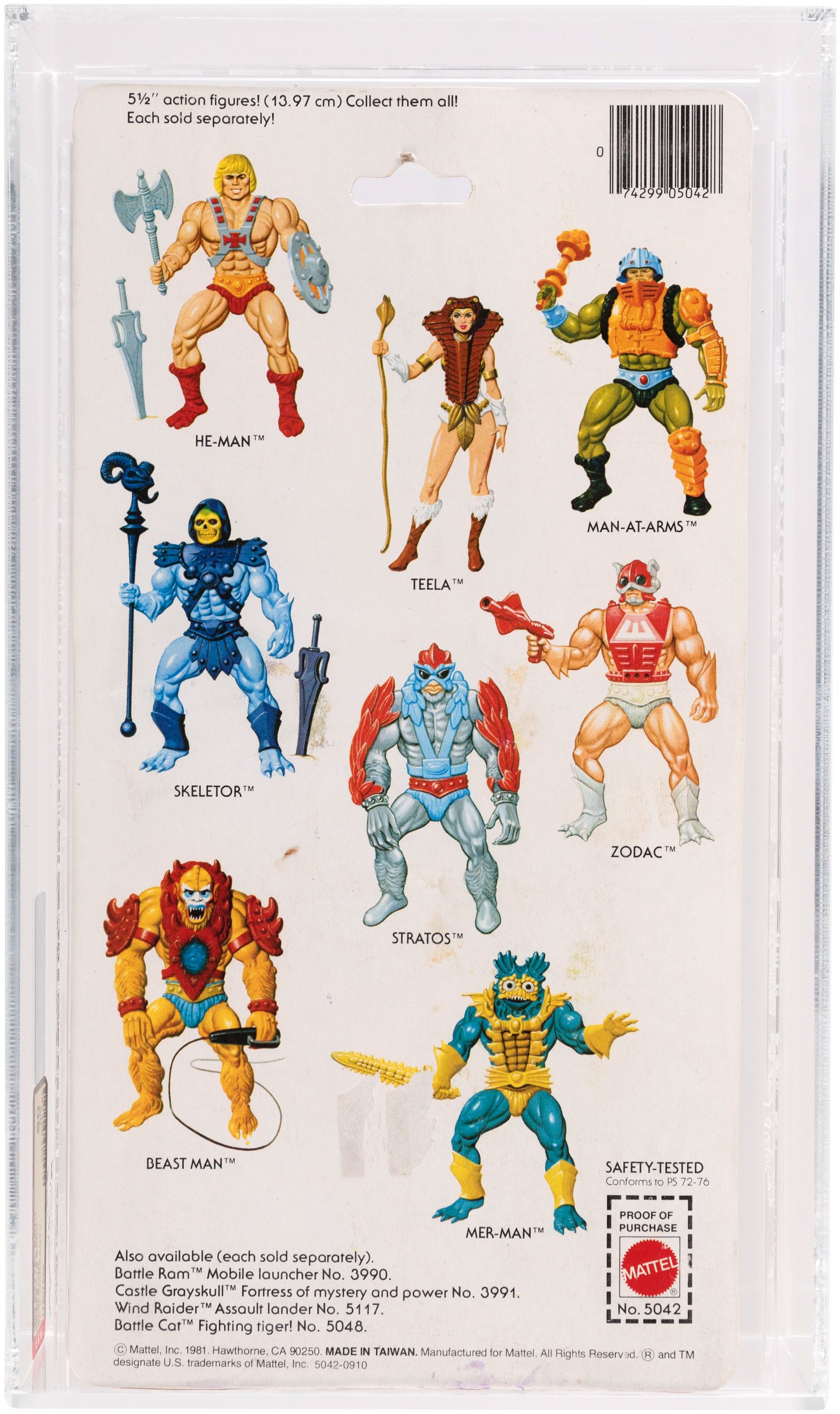
The images below show the evolution of the face paint on the Taiwan figures, in chronological order from top to bottom:

The images below show the evolution of the boots on the Taiwan figures, in chronological order from top to bottom:
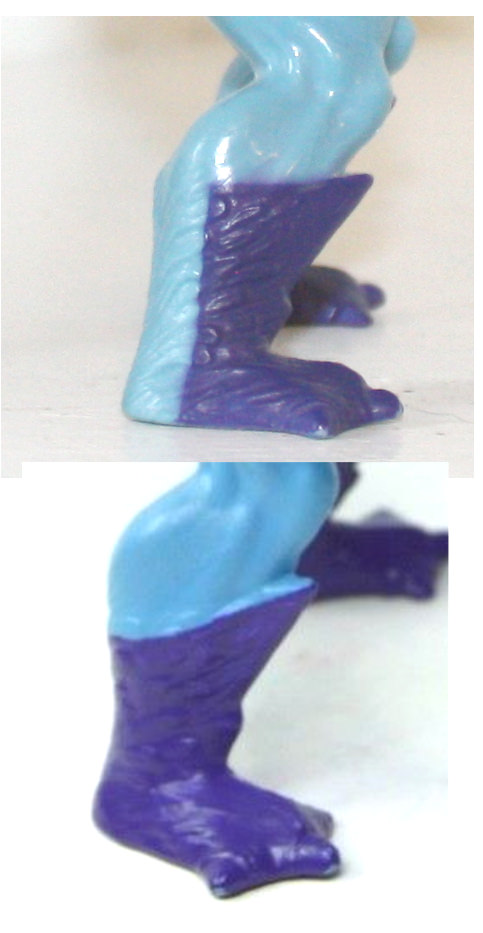
The images below show the evolution of the straps on the Taiwan figures, again in chronological order from top to bottom:
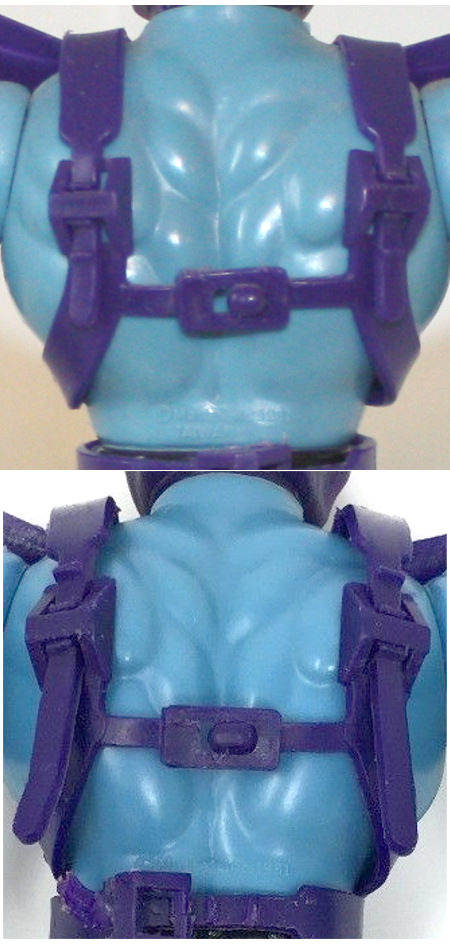
And finally, the images below show the evolution of the trunks and belt on the Taiwan figures, in chronological order from top to bottom:
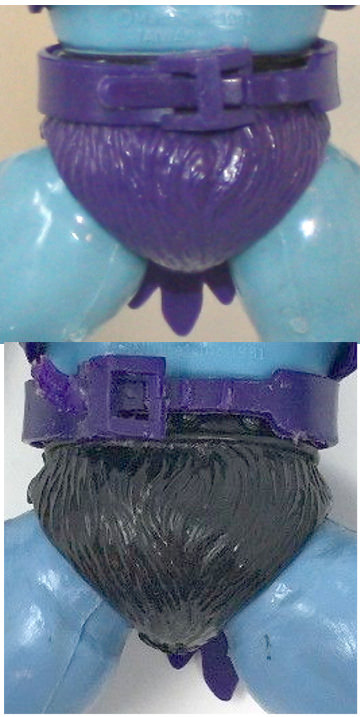
Battle Cat
There are at least three distinct very early Taiwan Battle Cats.
V1: Striped Tail Battle Cat
Only a handful of examples of this ultra-rare variant are known to exist. This version matches the color scheme of the original hand-painted prototype. Distinguishing characteristics include:
- Striped tail
- Orange around the mouth
- Teeth painted white front and back
- Stripes crisscross over part line on back
- Longer, rough-looking stripes on the left shoulder
- Extra stripe on right front leg
- Marked “© Mattel, Inc. 1976 Taiwan” on inner right rear leg
- White dots in eyes
- Marked “1” underneath saddle and helmet
- Textured “fur”
You can spot this variant in early catalog pictures of MOTU figures. The orange lines on this cat match the black lines on the original Big Jim Tiger the figure is based on. It also has finely textured fur (difficult to see unless it’s in hand), again like the Big Jim Tiger.
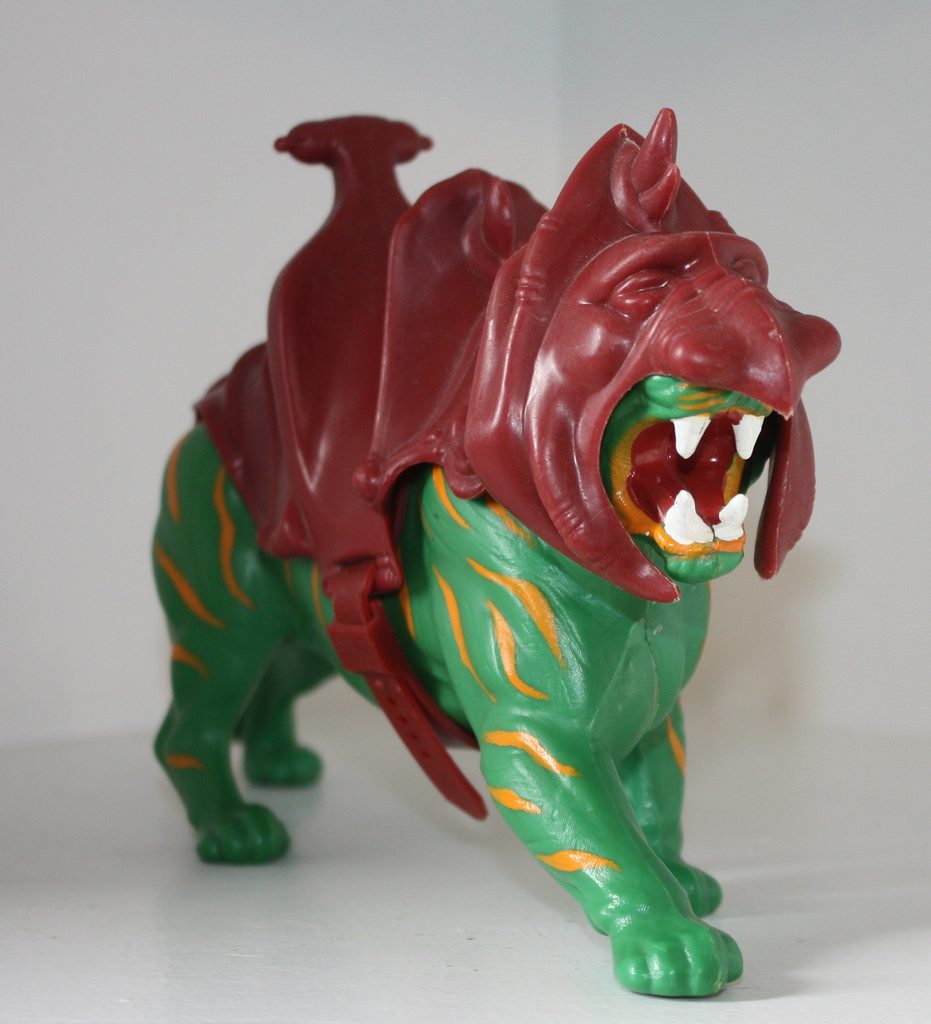
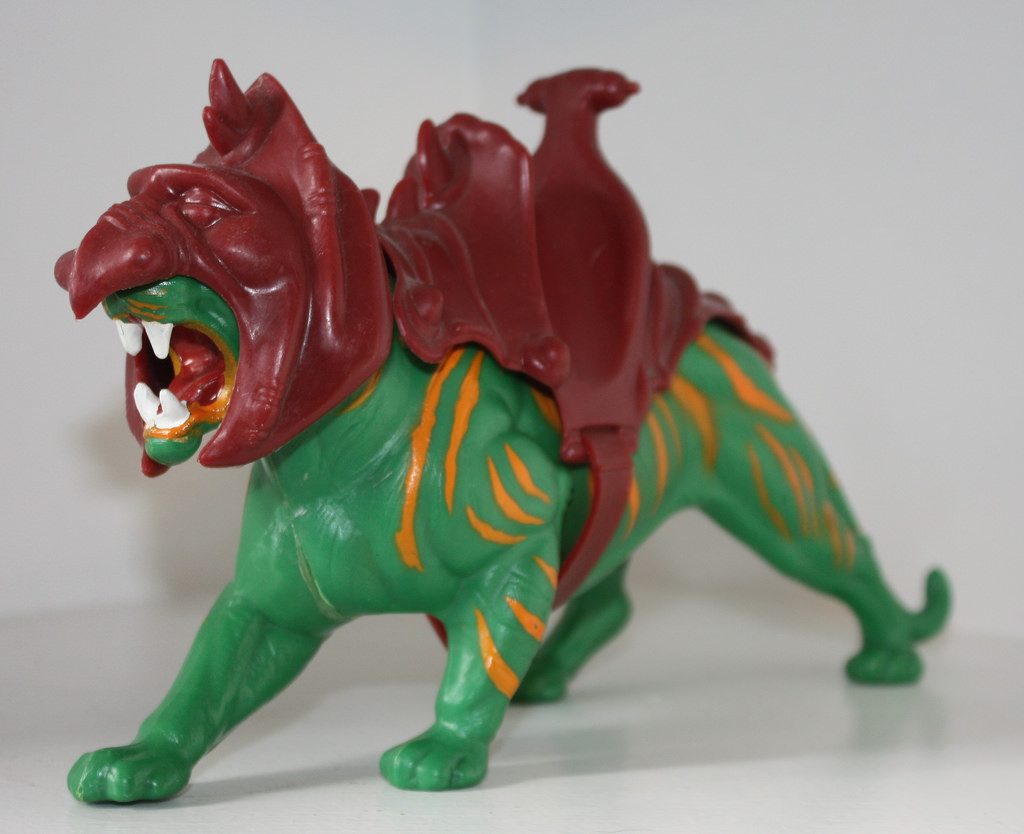
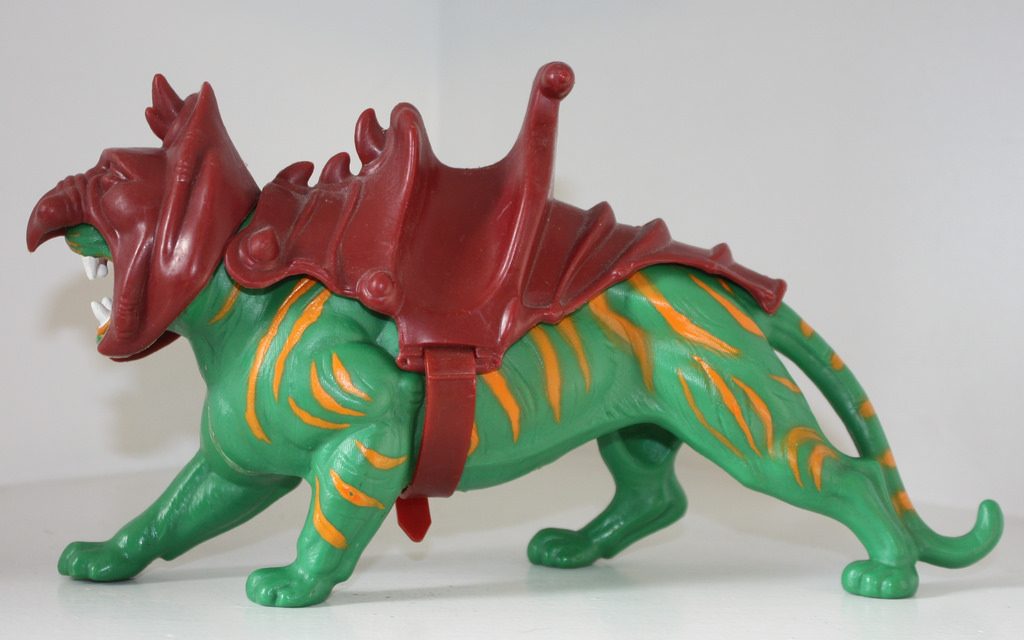
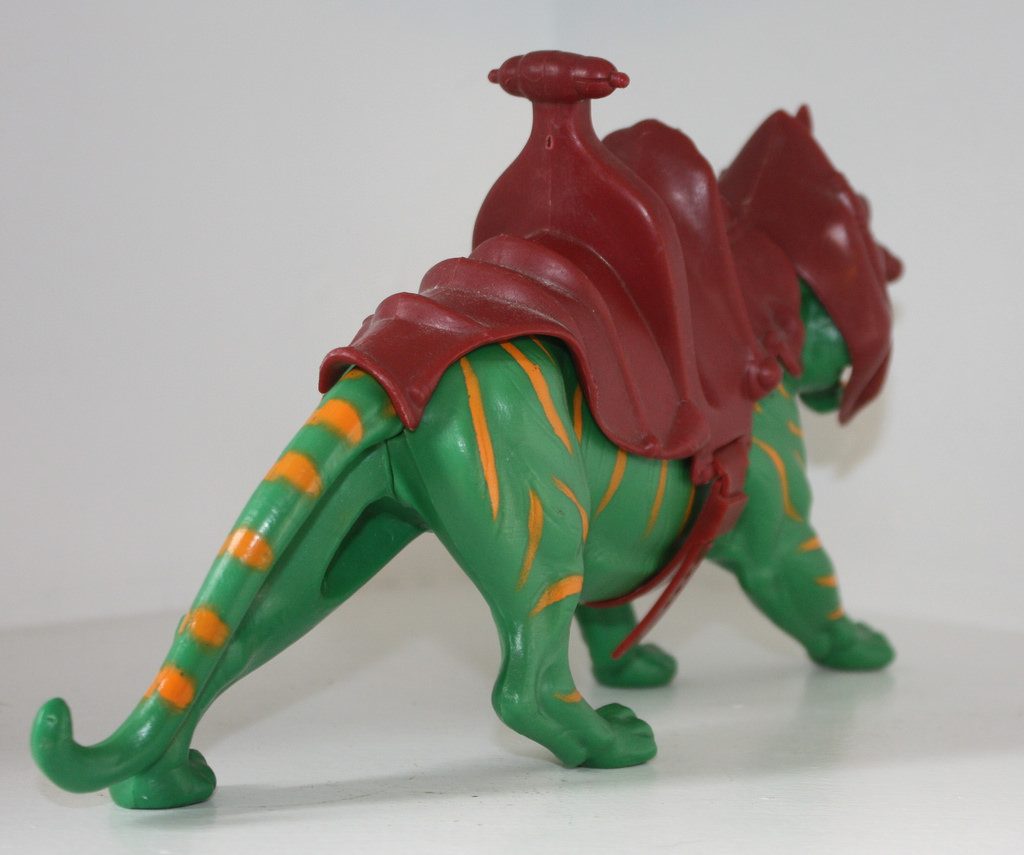
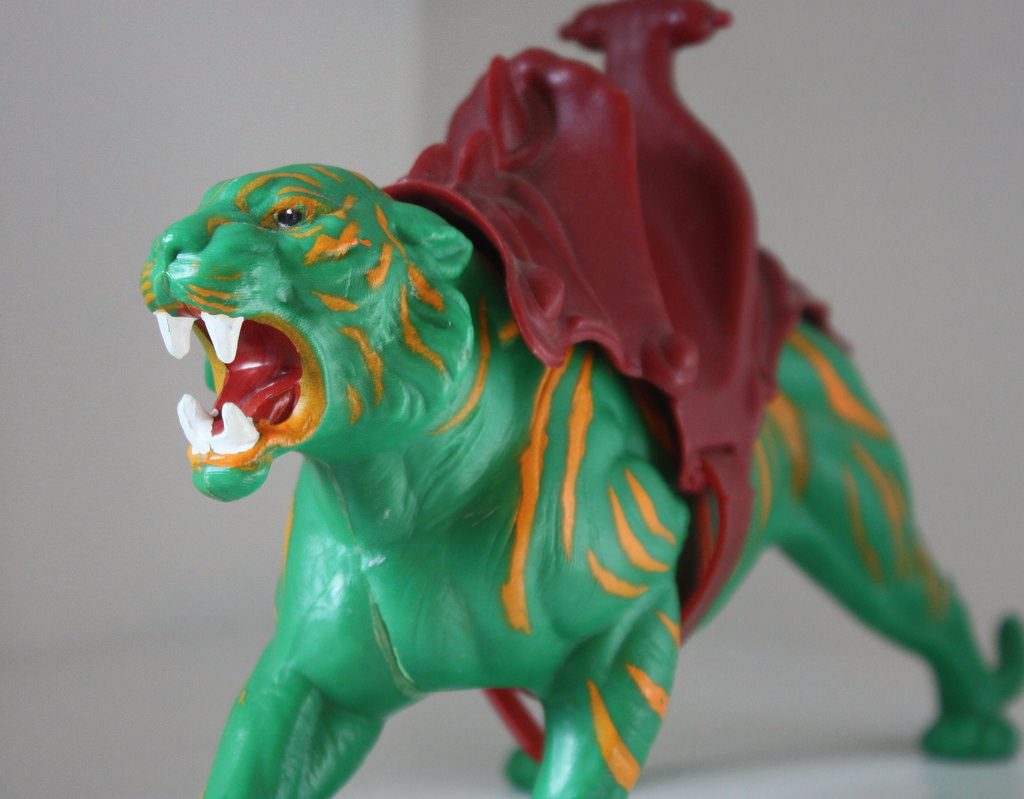
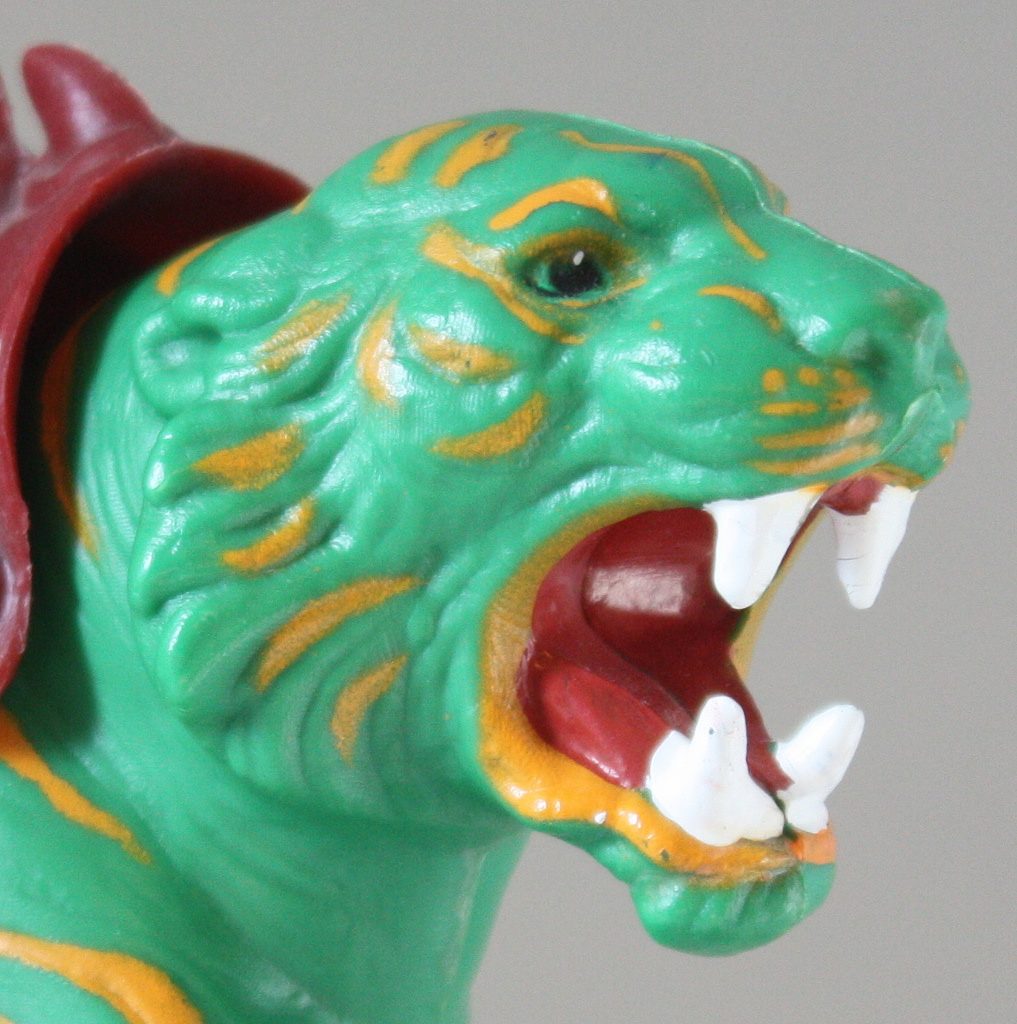

V2: Textured Battle Cat
The first mass-produced version of the Taiwan Battle Cat retains the textured “fur” of the first sample version (and the Big Jim Tiger), but omits the extra orange paint applications on the mouth and tail. The teeth are also only painted white from the front. Like the rare striped tail model, it is marked © Mattel, Inc. 1976 Taiwan. It also is marked “1” underneath the saddle and helmet.

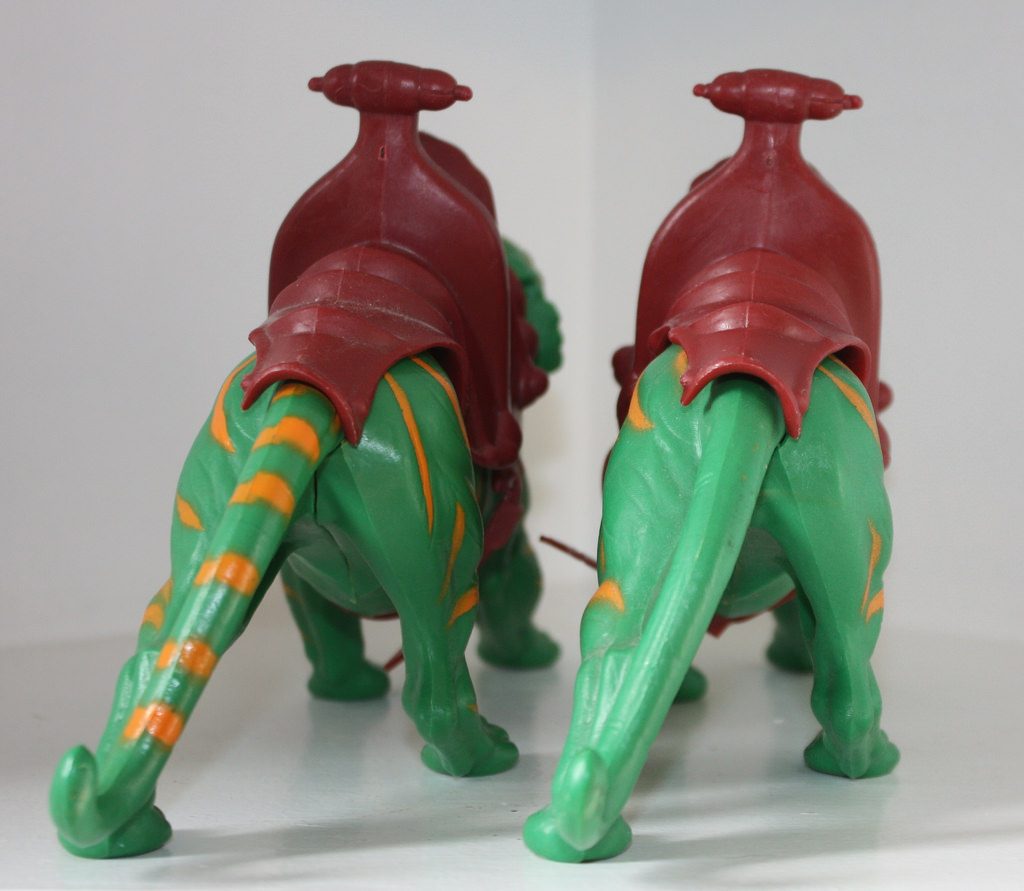
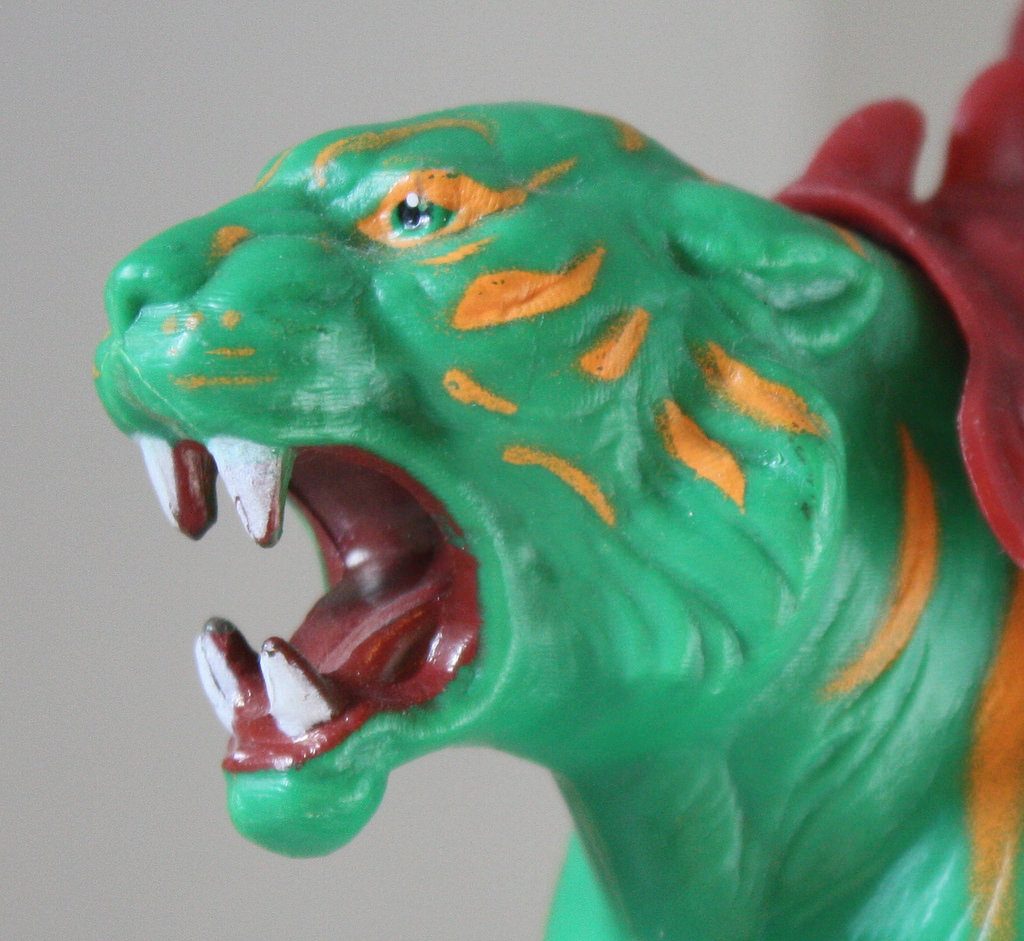
V3: Non-Textured Battle Cat
The next incarnation of the early Taiwan Battle Cat is missing the texture from V1 and V2. It’s marked © Mattel, Inc. 1978 Taiwan. It also is marked “1” underneath the saddle and helmet, and retains the white dots in the eyes. The orange paint is somewhat lighter than previous versions. My particular example came from a damaged early 1982 Battle Cat box featuring only the 1982 cross sell art on the back. It also seems to have a brighter red saddle and helmet, although this doesn’t necessarily come across in the photos below. I’m not sure if the textured version was more likely to come in either the single Battle Cat box or the early He-Man/Battle Cat gift sets – it’s difficult to tell with mint in box examples whether or not the texture is present.
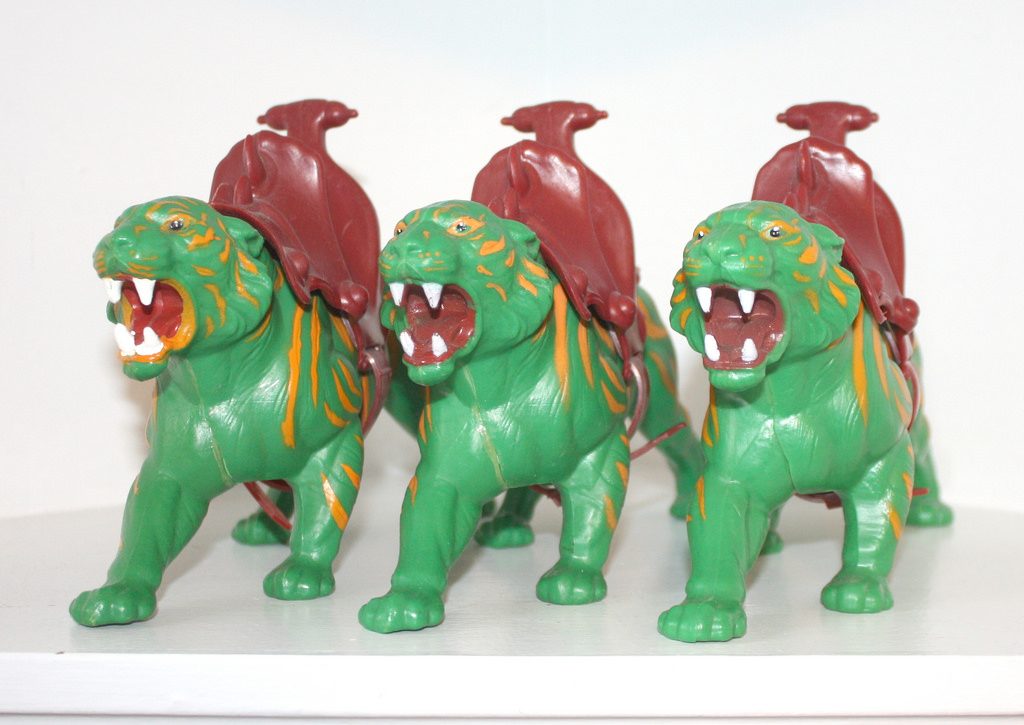
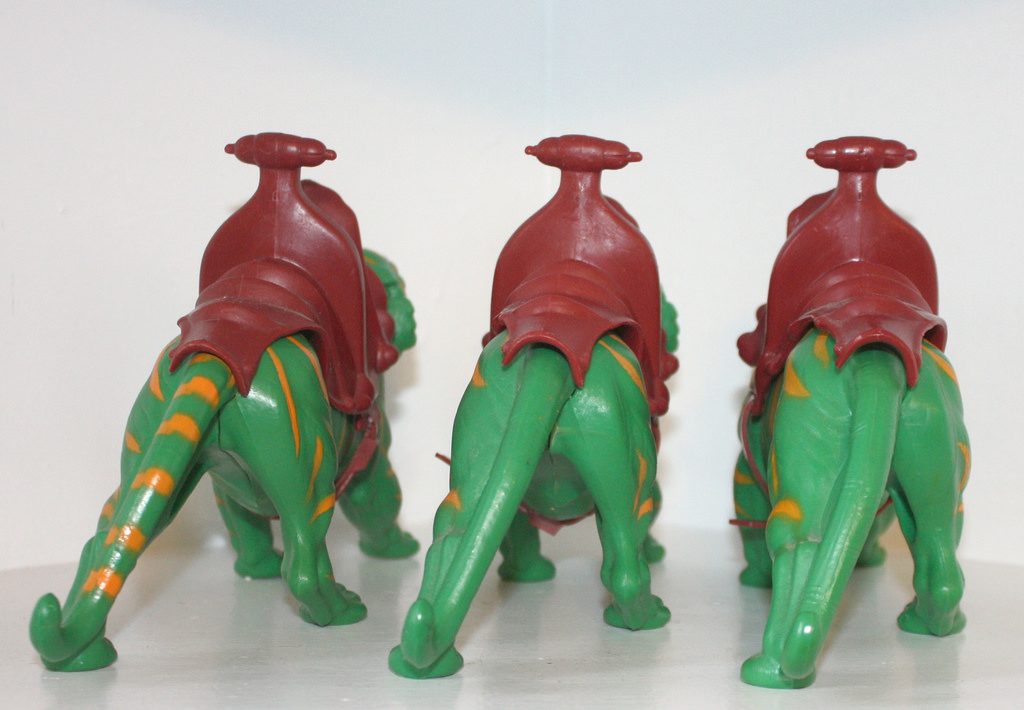
Man-At-Arms
The first Taiwan release of Man-At-Arms has the following characteristics:
- Red dots on his helmet
- Blue belt, in the same color as his helmet
- Light to medium green body and light orange armor
- Short straps at the back of the armor
- Light red trunks/boots, similar to He-Man’s
On the example below, the chest armor is marked 5041-2289A © Mattel Inc. 1981. All the other accessories are unmarked.
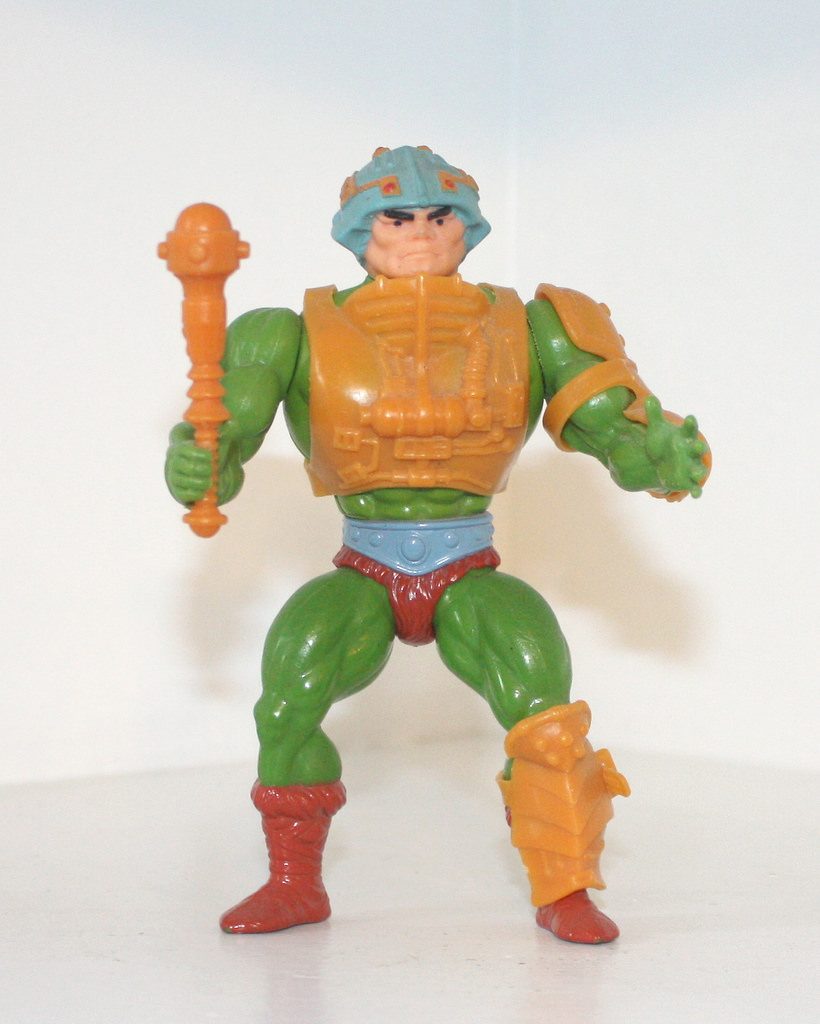
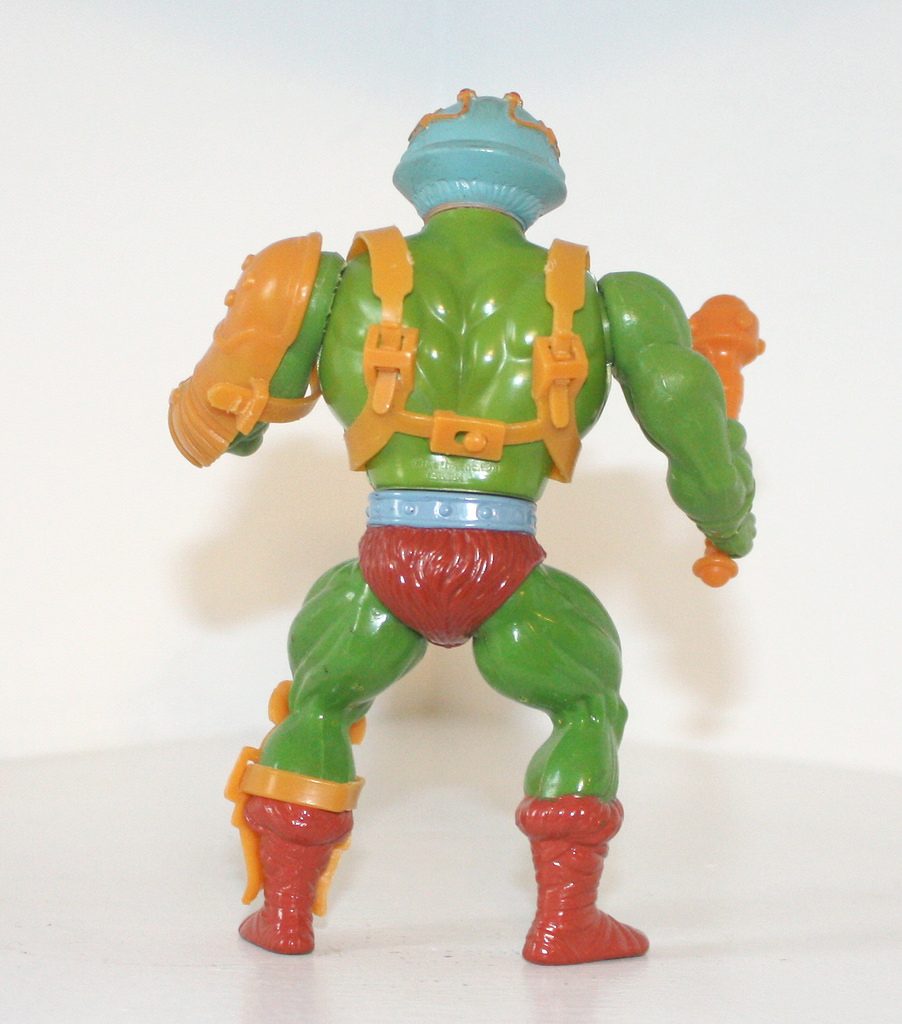
The next Taiwan releases omitted the red dots, and have longer straps at the back of the armor. Later Taiwan releases feature a gray belt and much darker colors all around, and a helmet that is somewhat teal-colored.

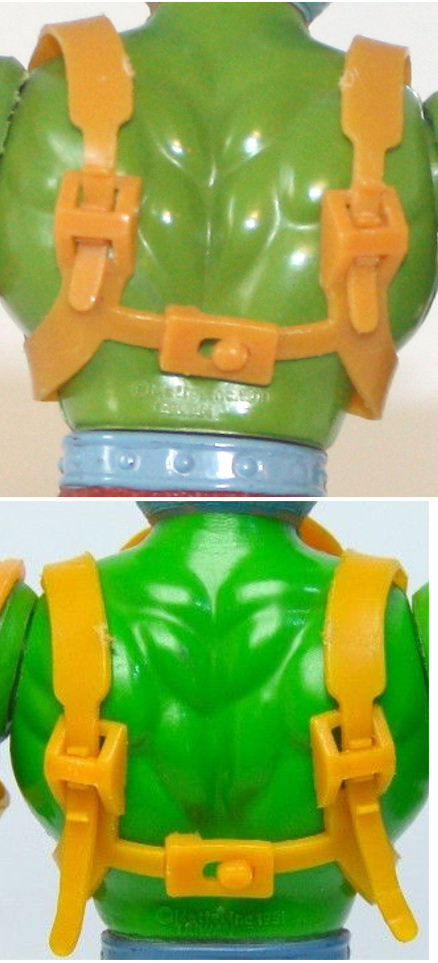

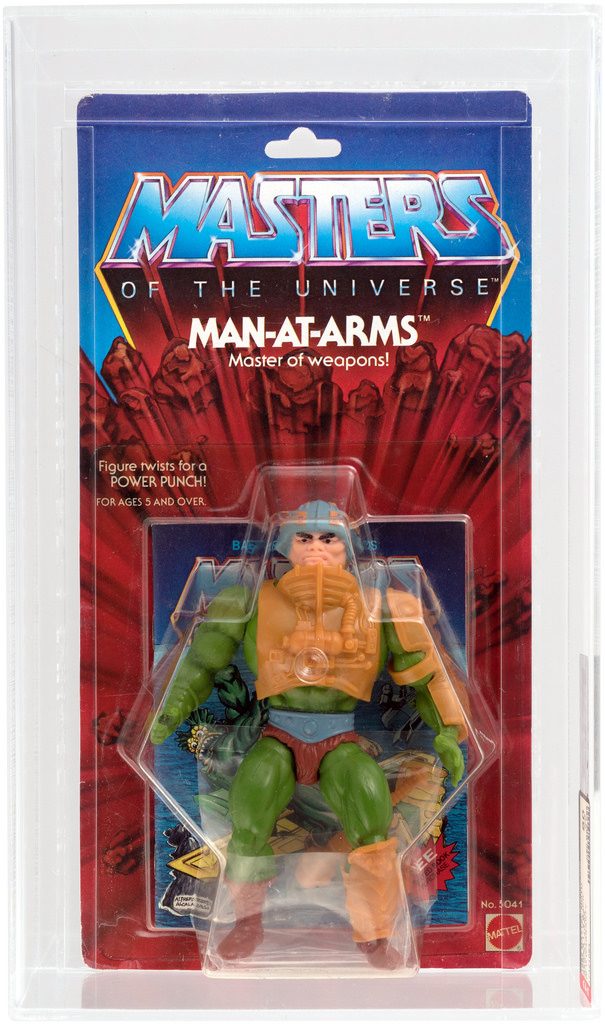
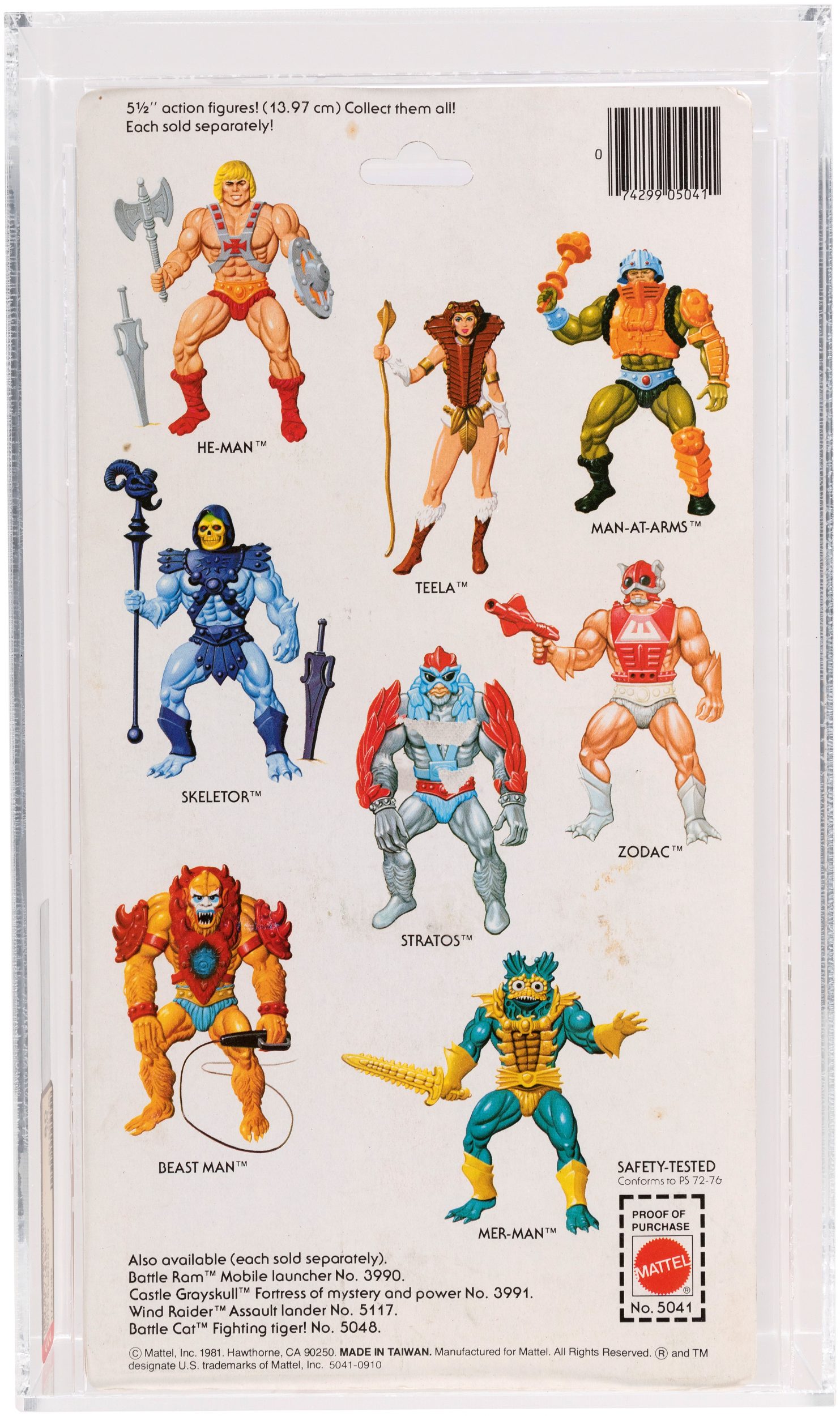
Beast Man
Early Taiwan Beast Man figures aren’t dramatically different from later versions. The most obvious differences are that the first versions have white dots in the eyes (some of them, at least – I’ll get into that), light blue face paint, even and circular blue paint on the front of the armor, and a short strap around the back of the armor. I believe I have identified some differences between the “test market” G0 figures and the subsequent G1 release.
There are two variants available on the initial “test market” cards – a version without dots in the eyes, and a version with bright white dots in the eyes. I have now seen examples of both on the first release packaging. I really can’t say which came first, although the version with dots more closely follows the intended design, based on the look of a hand-painted Beast Man prototype.
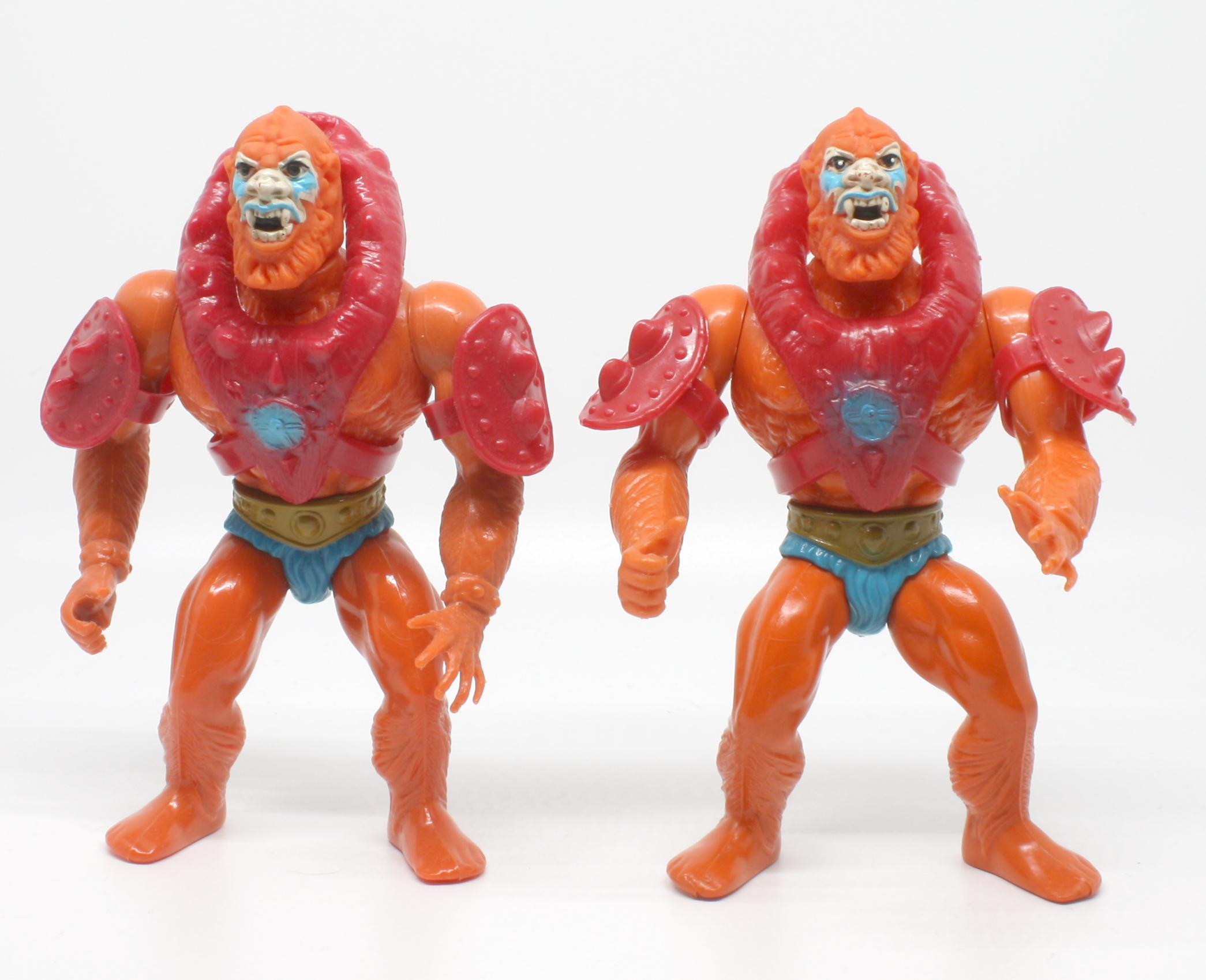

I would also note that the whips on these first release figures don’t fit as well in the figures’ hands. That seems to have been corrected with later releases.
The second “G1” card release often has the dots on the eyes as well, but the dots are more of an off-white color, like the rest of the face. The armor also tends to be slightly more pinkish. On both G0 and G1 versions, the strap around the back of the figure is short. The G1 version often has no waist stopper on the spring waist feature.

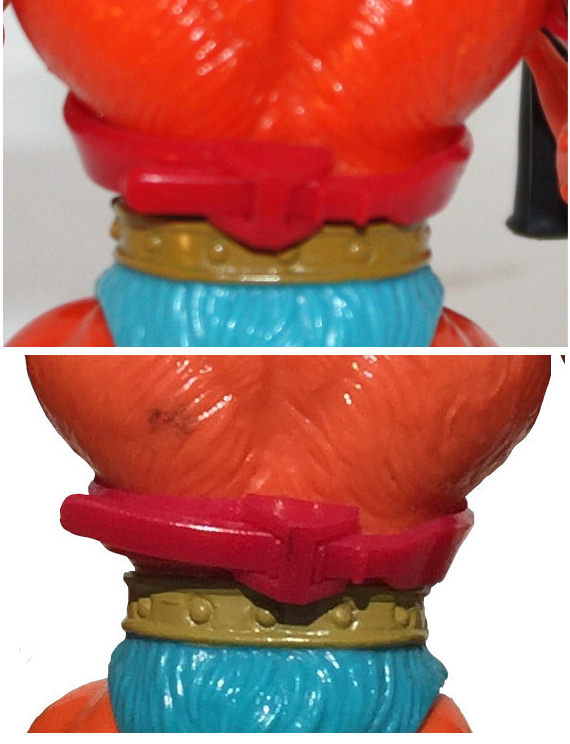



Below is an example of a very early carded Taiwan Beast Man, which can be recognized by the lack of warranty and lack of SKU/character subtitles on the back. This version lacks the dots in the eyes. The off-white dots seem to be prevalent on G1 and G2 cards 8-back cards.

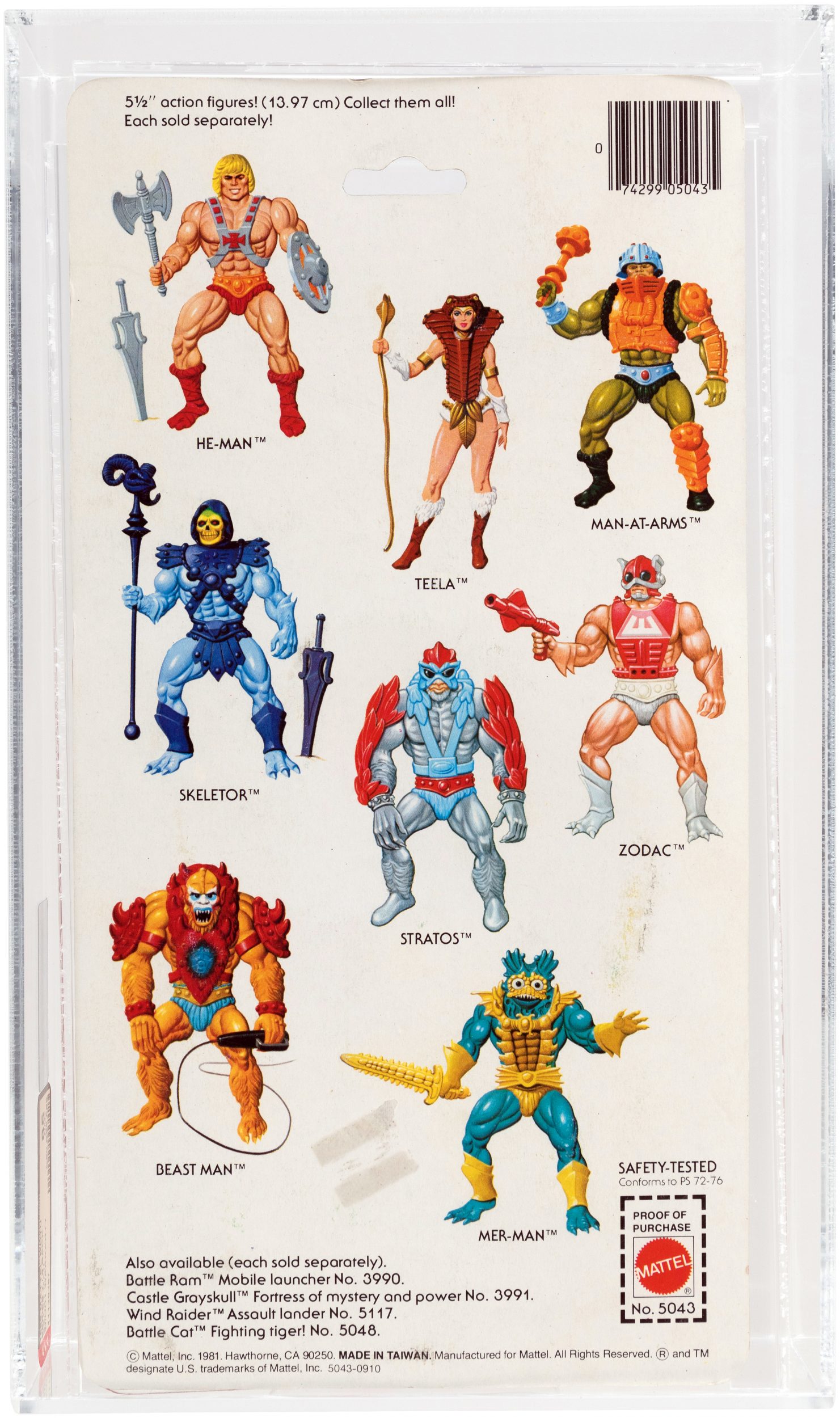
Olmo (catone82) shared with me some images he found of a G0 “test market” card for Beast Man (owned by MOTU Gefter), which does feature white dots. These do seem to be the bright white dots, although I’m going to try to get that verified with the owner of this figure.

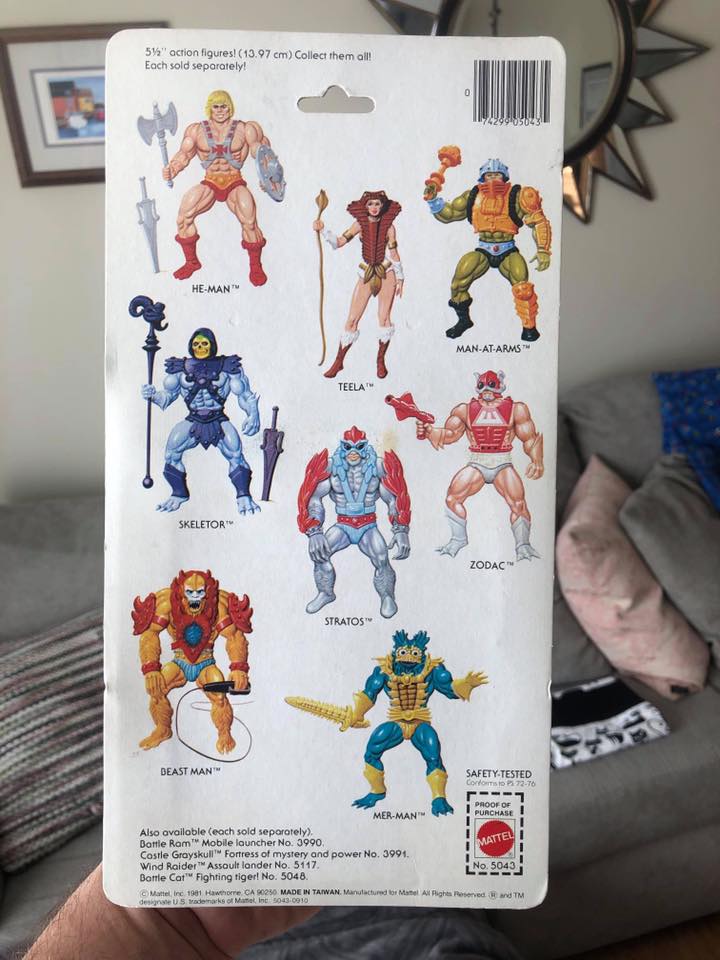
Covered in part two: Stratos, Mer-Man, Teela, Zodac, Castle Grayskull, Battle Ram and Wind Raider.
Want to support the blog? Consider becoming a Patreon supporter. You’ll also gain access to exclusive content and early access to posts on the blog. Alternatively, you can do your toy shopping through my Entertainment Earth affiliate link, below. Thank you!
